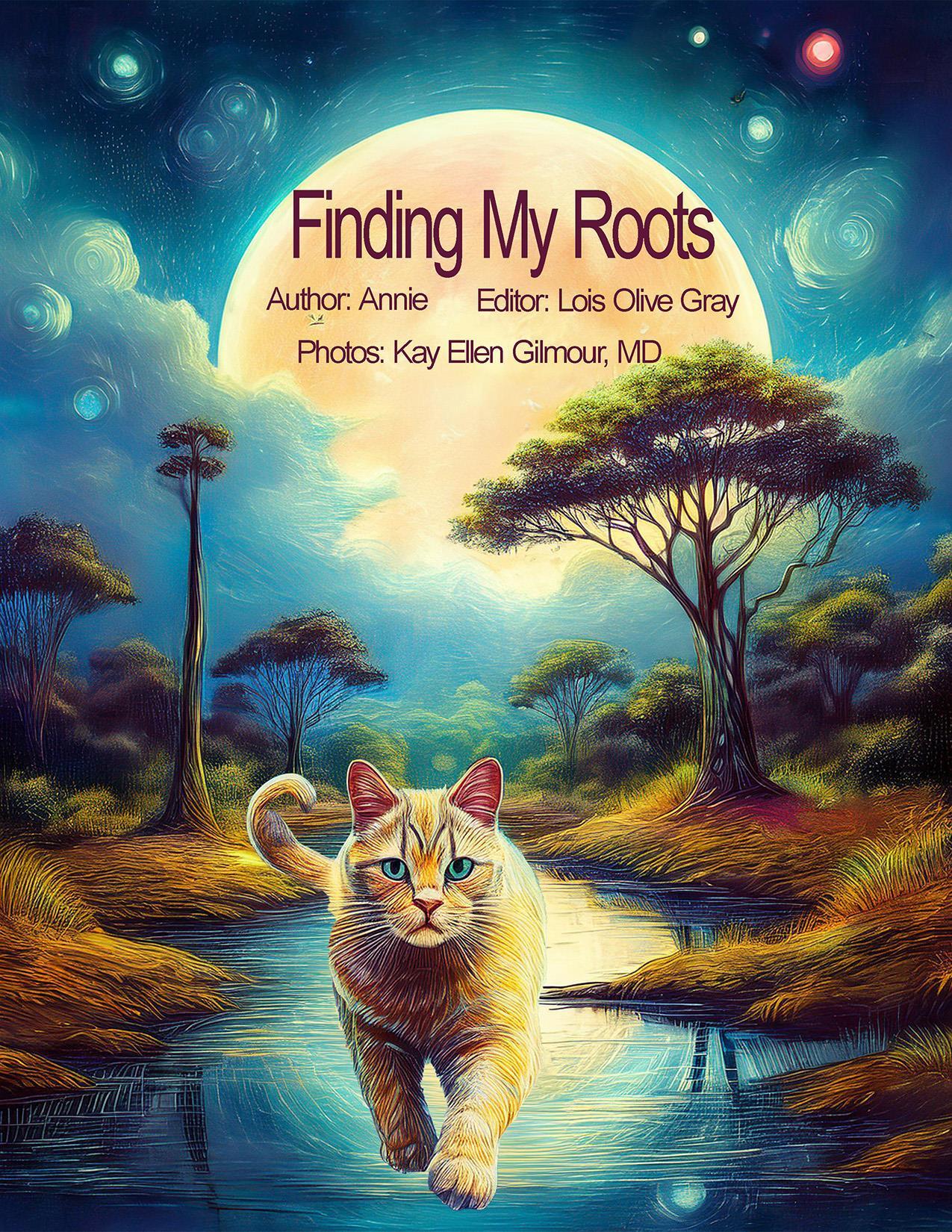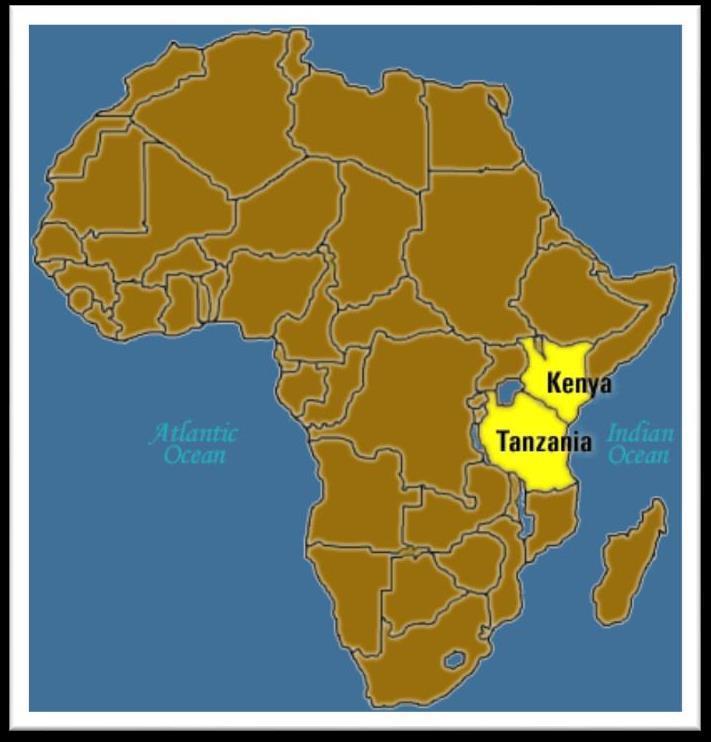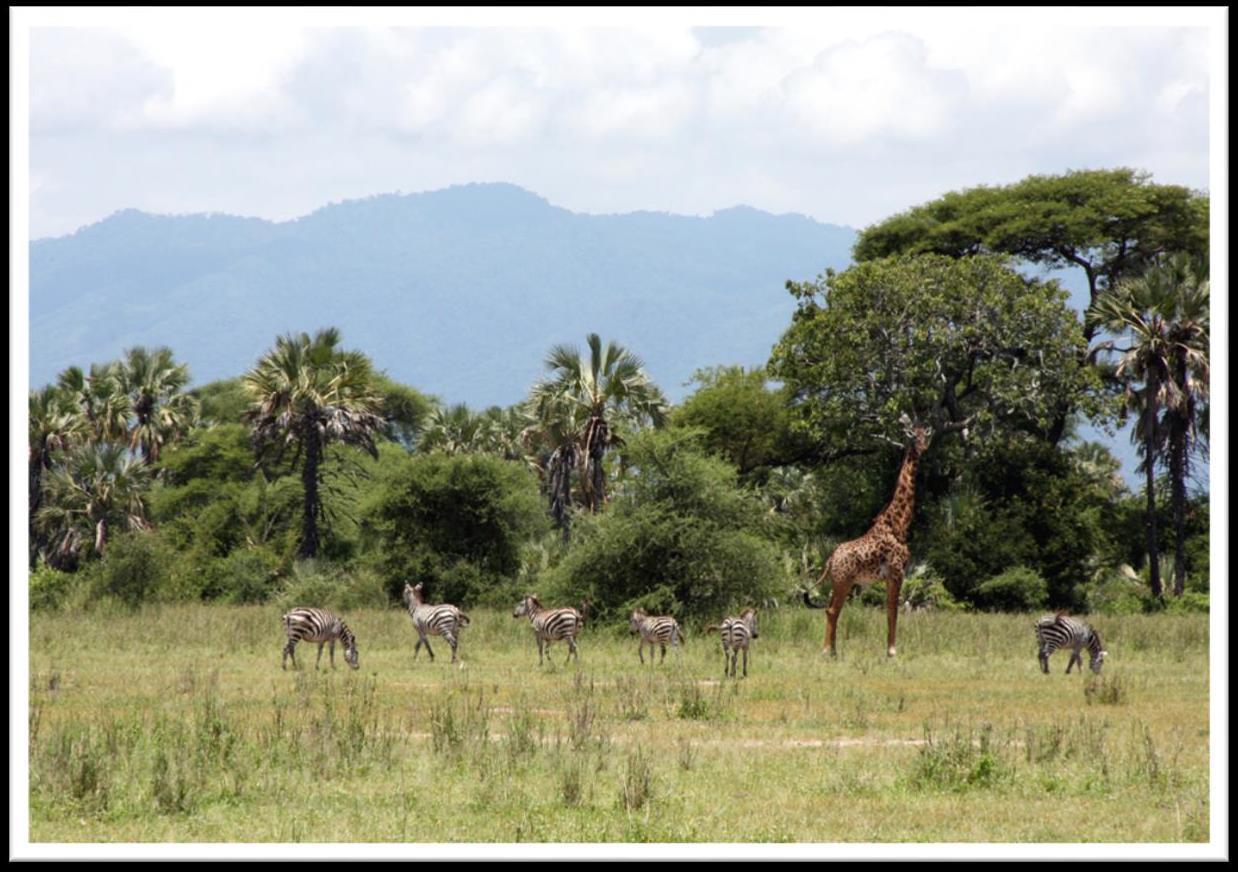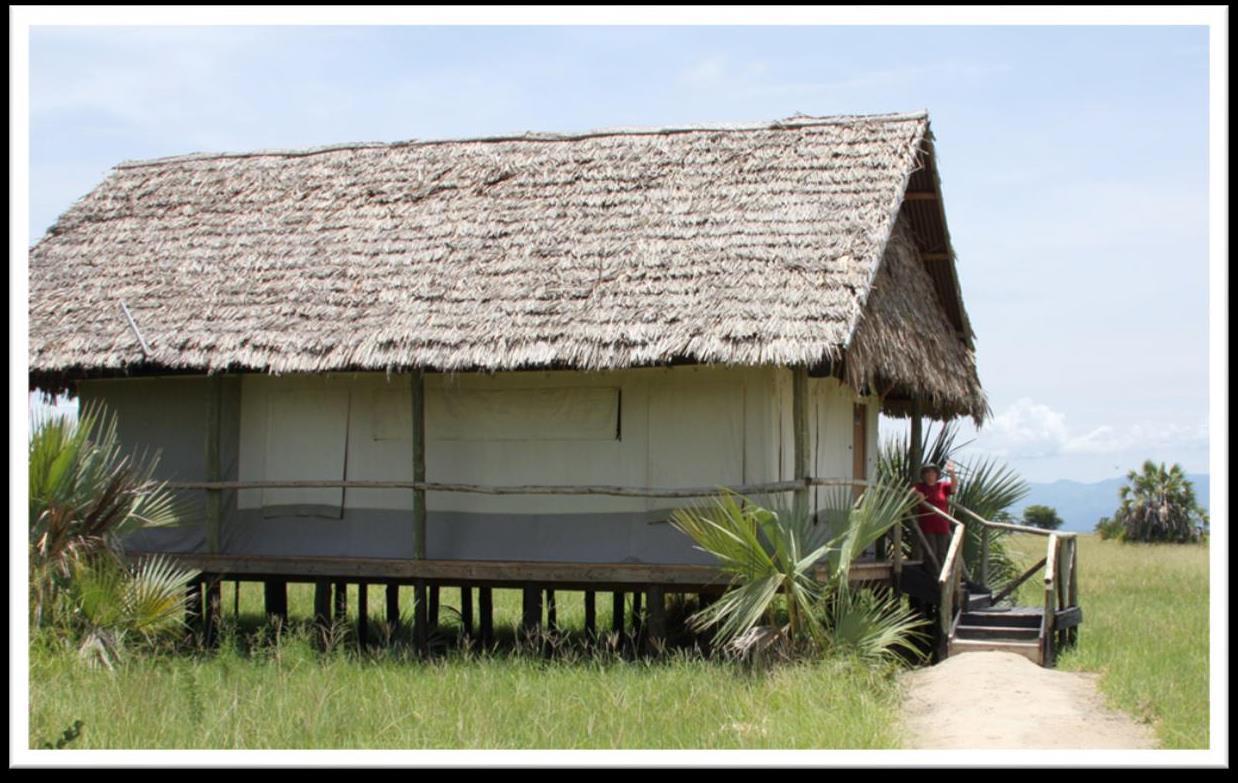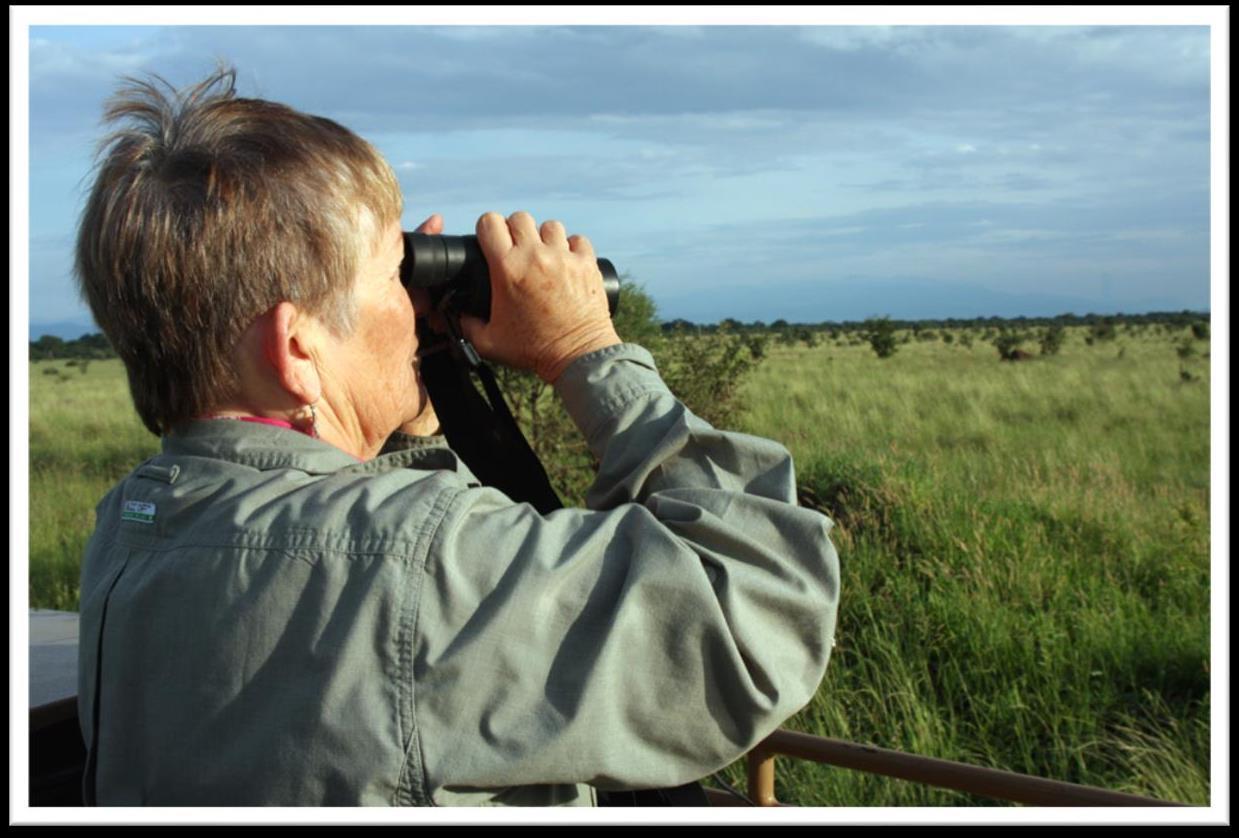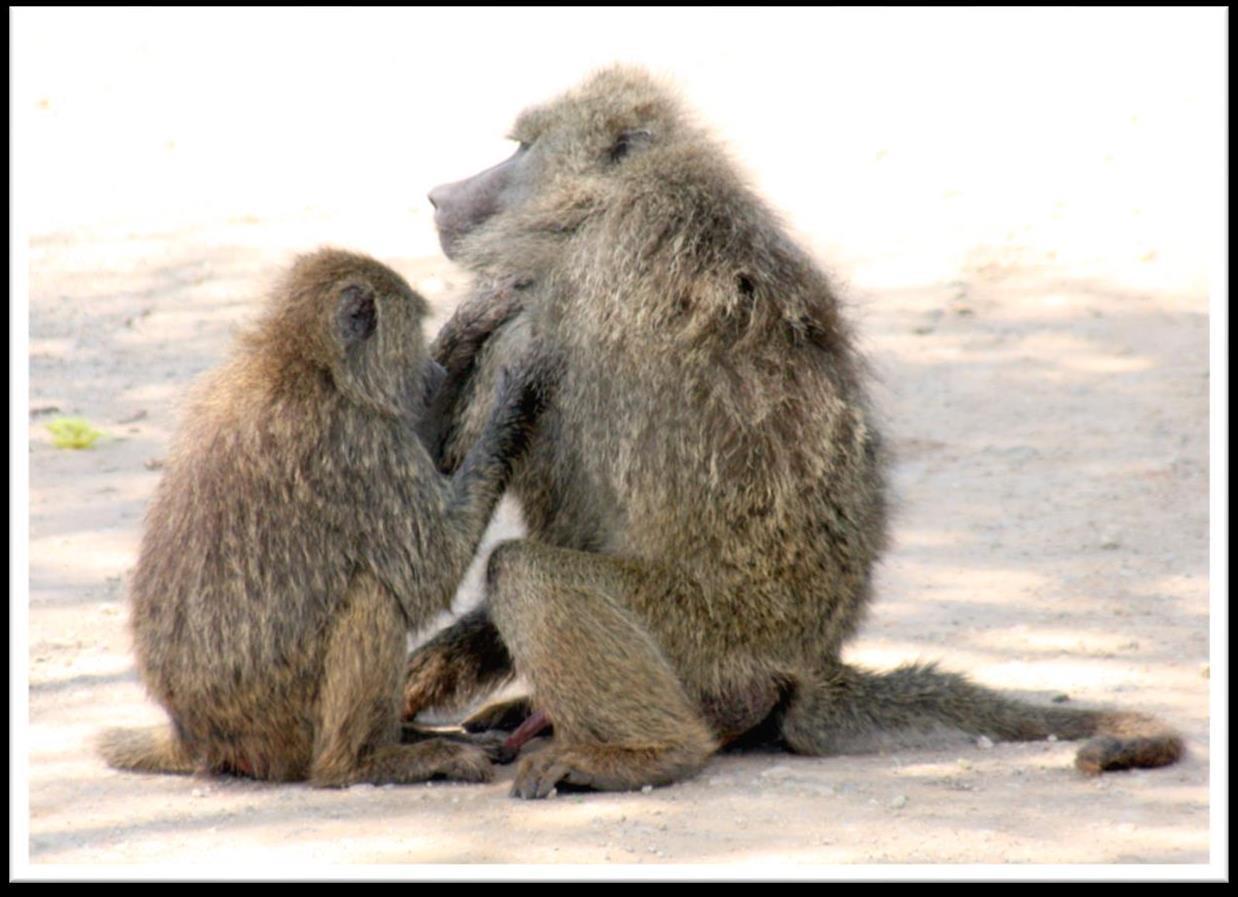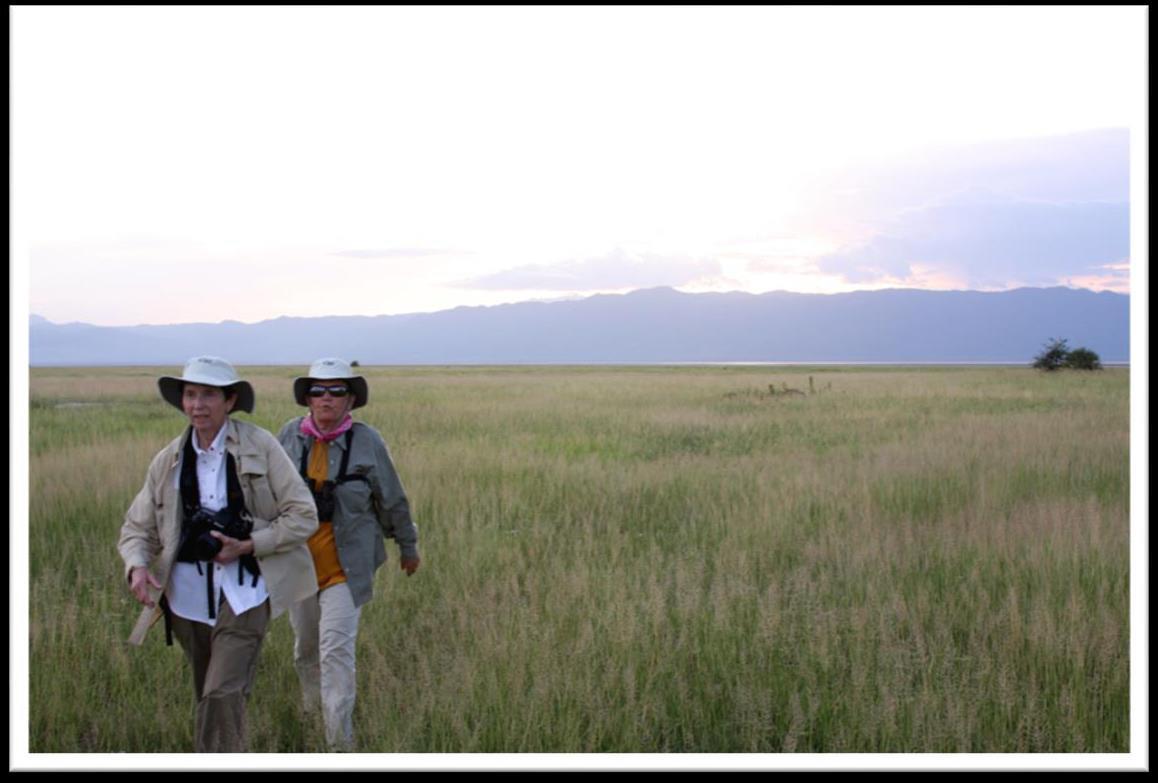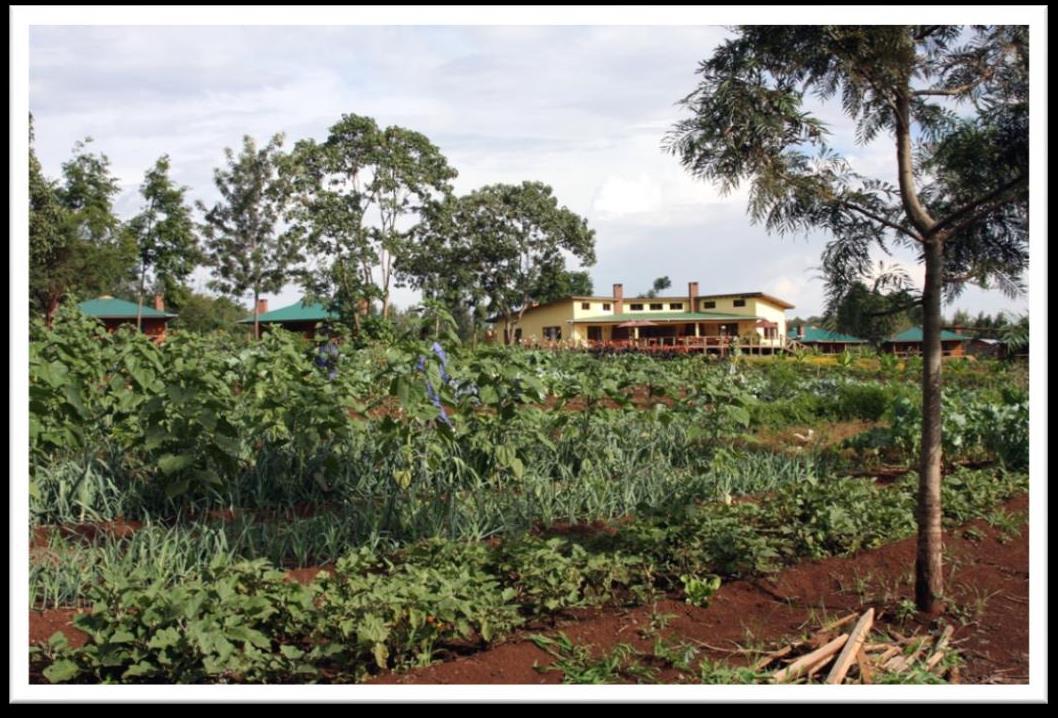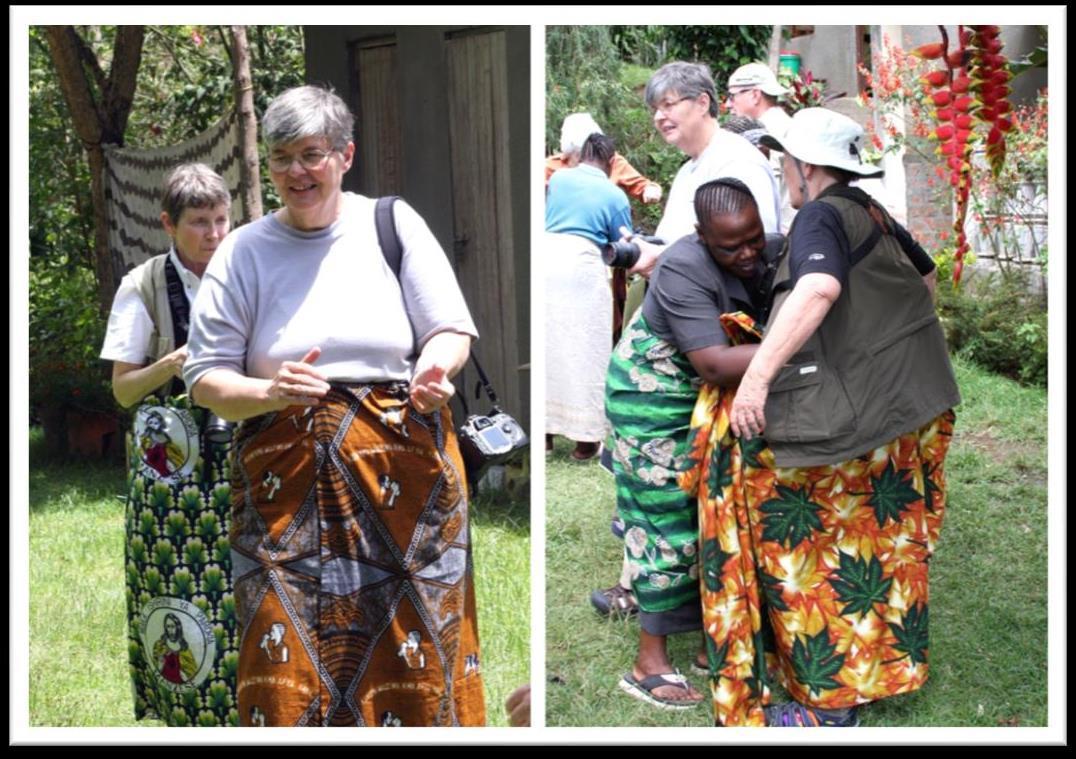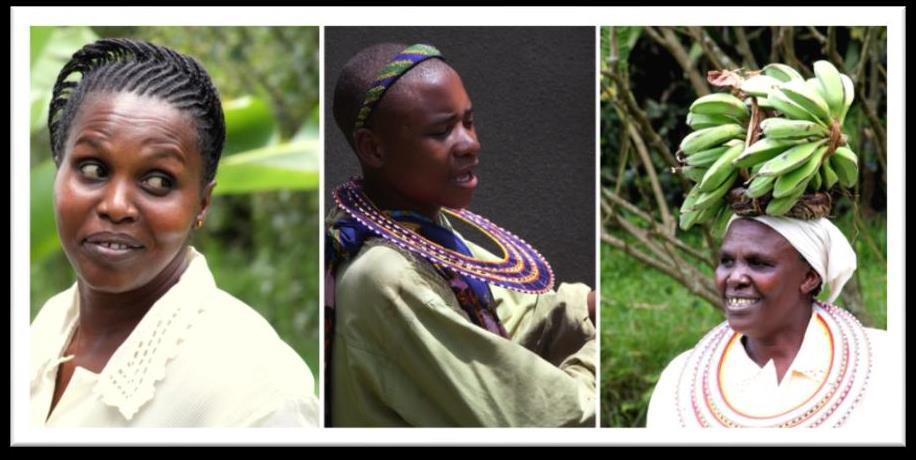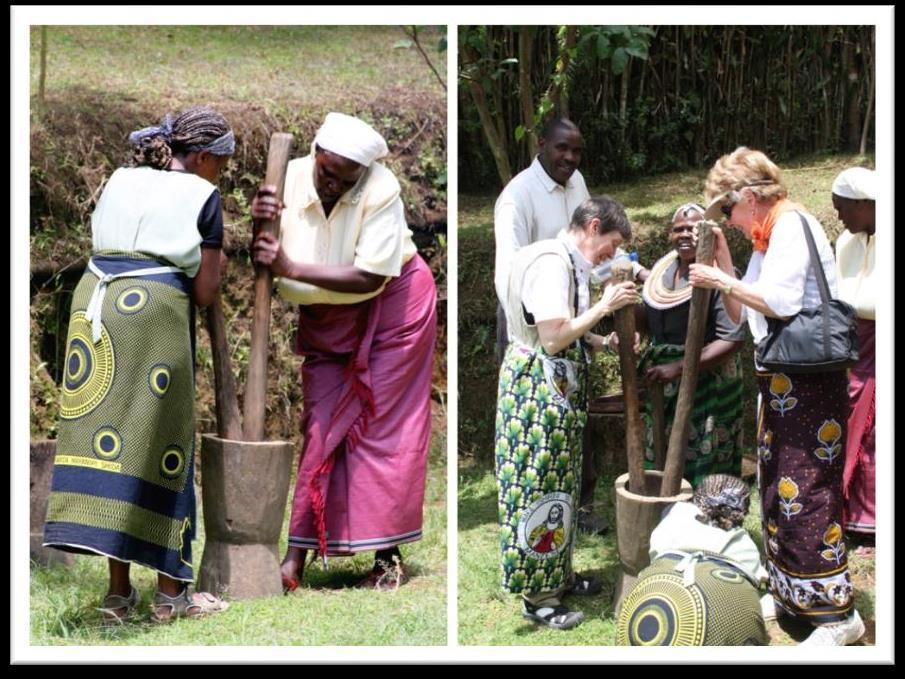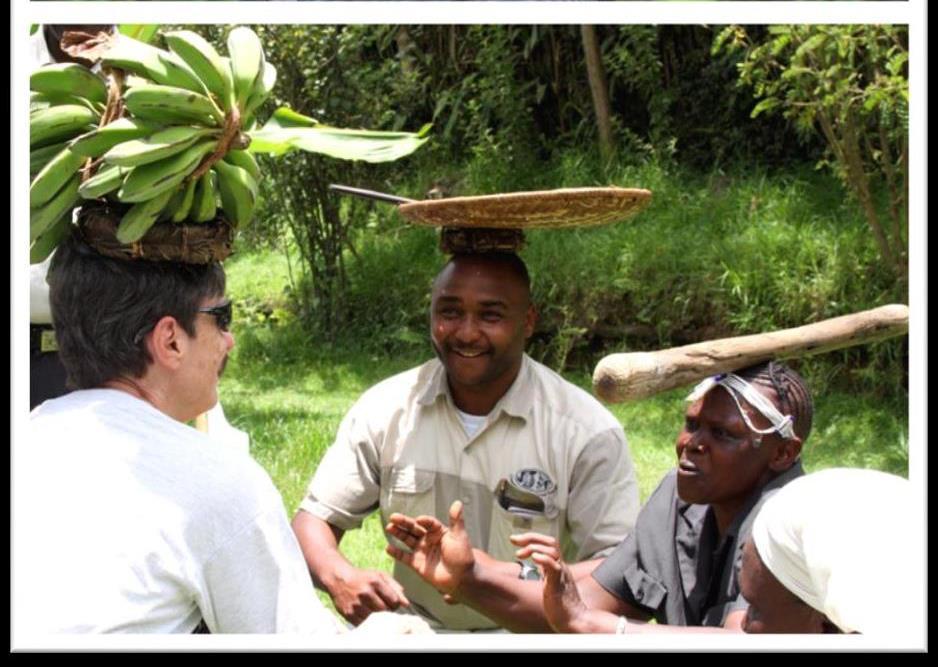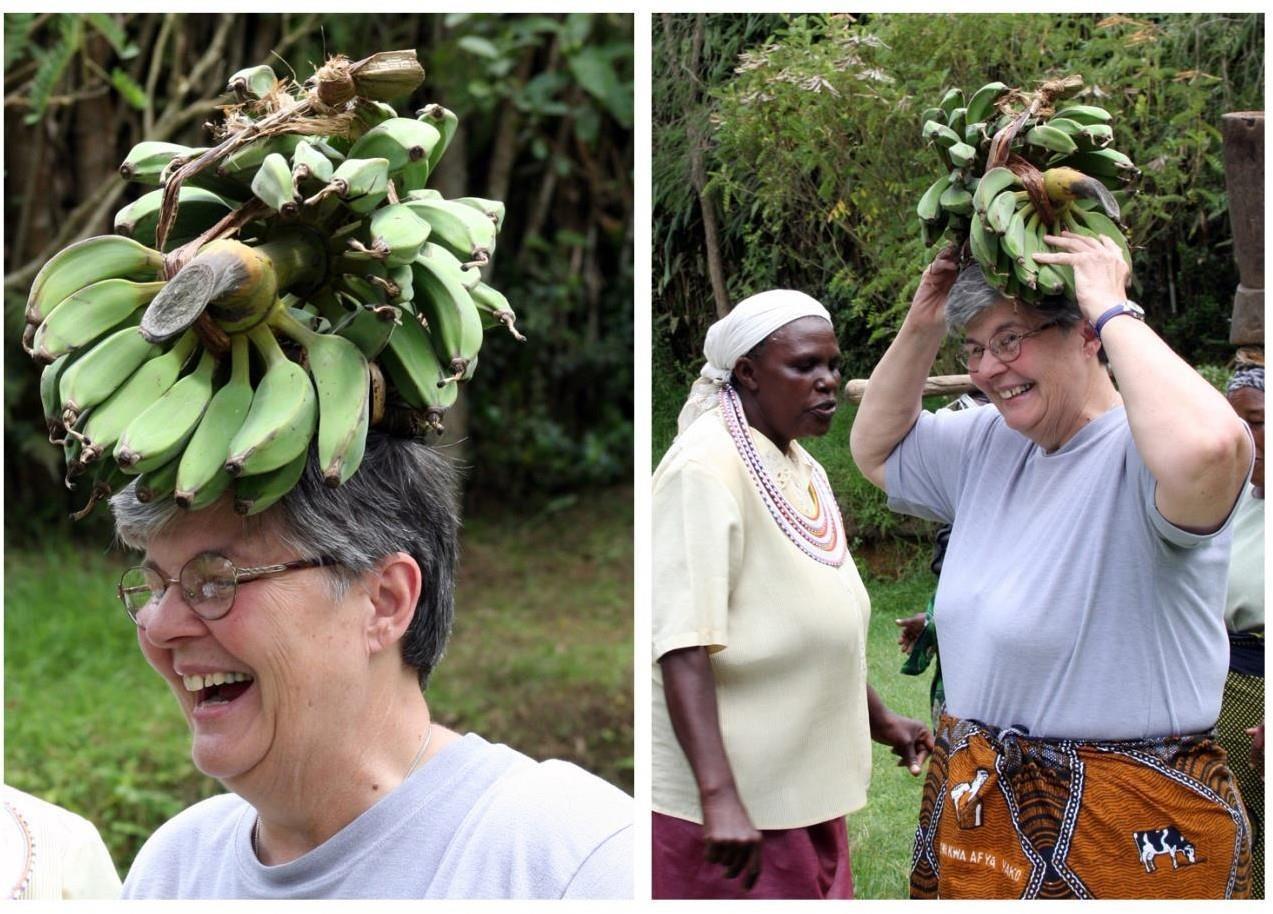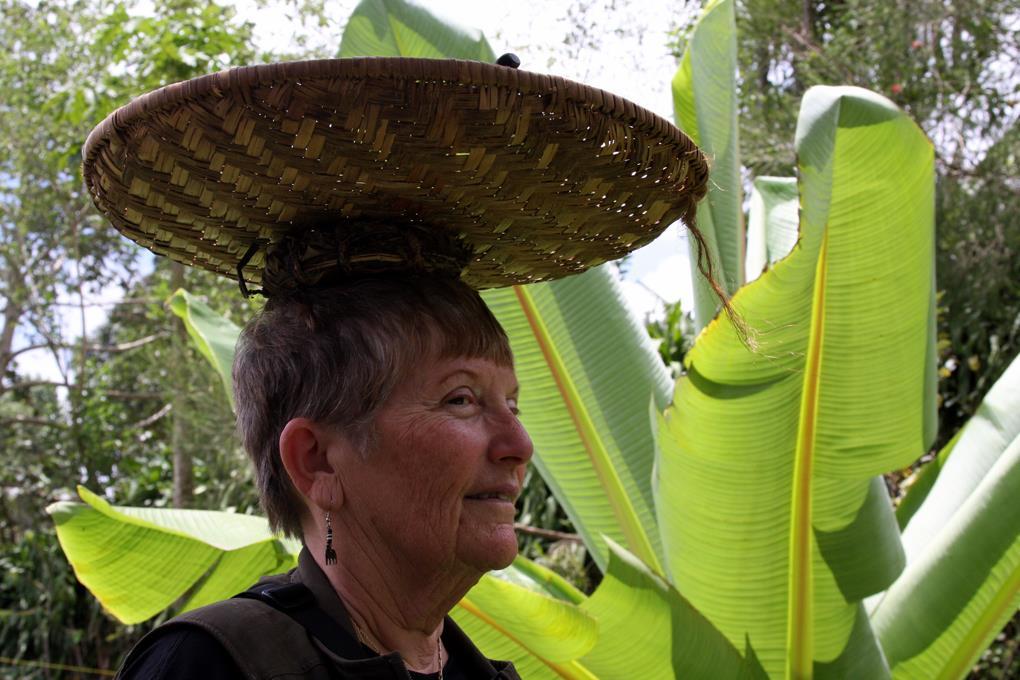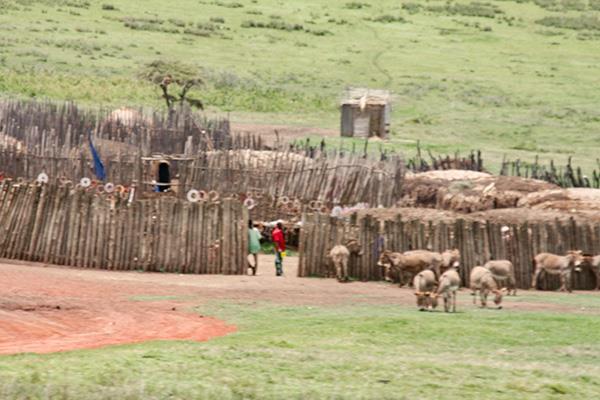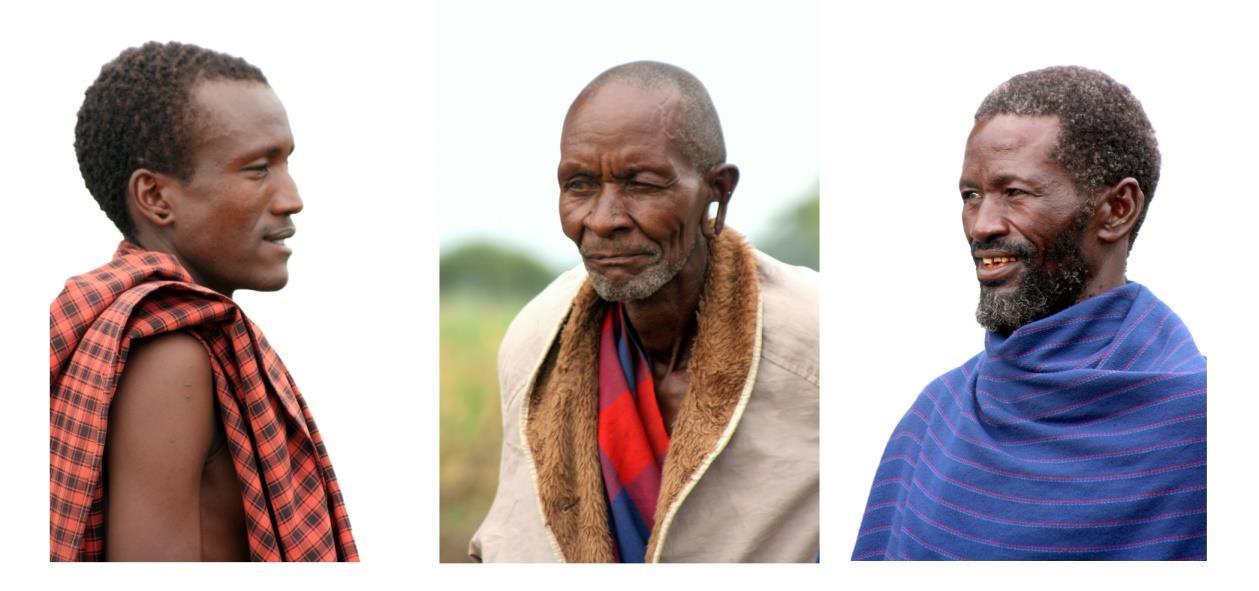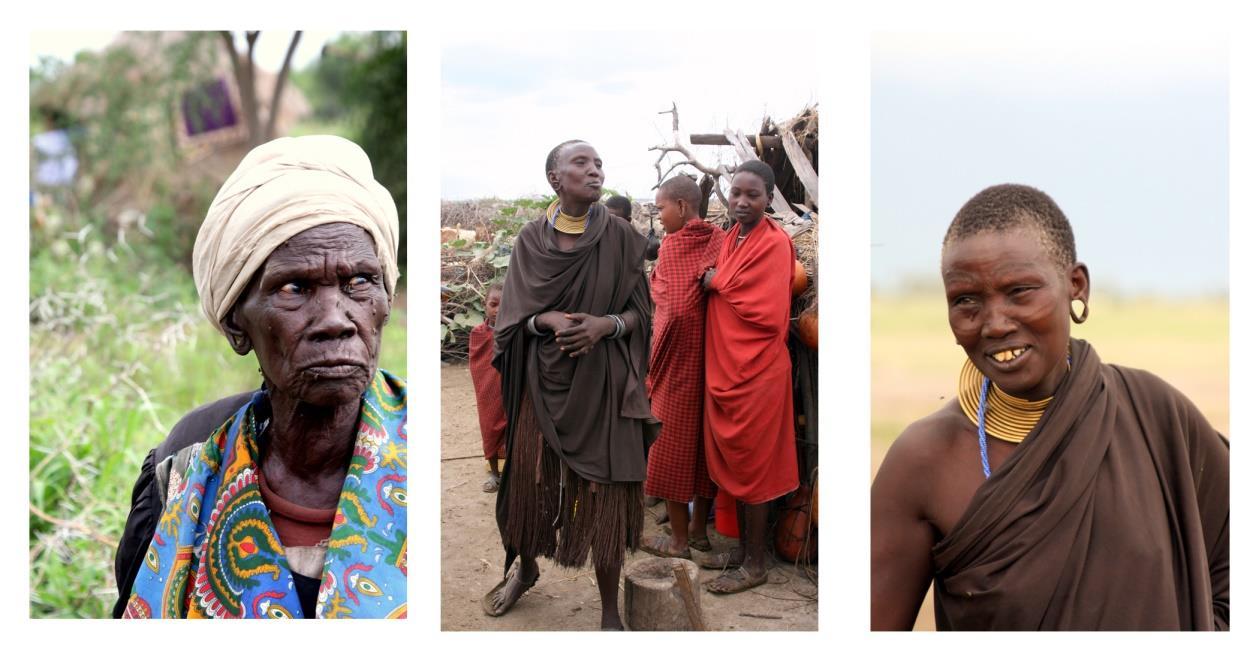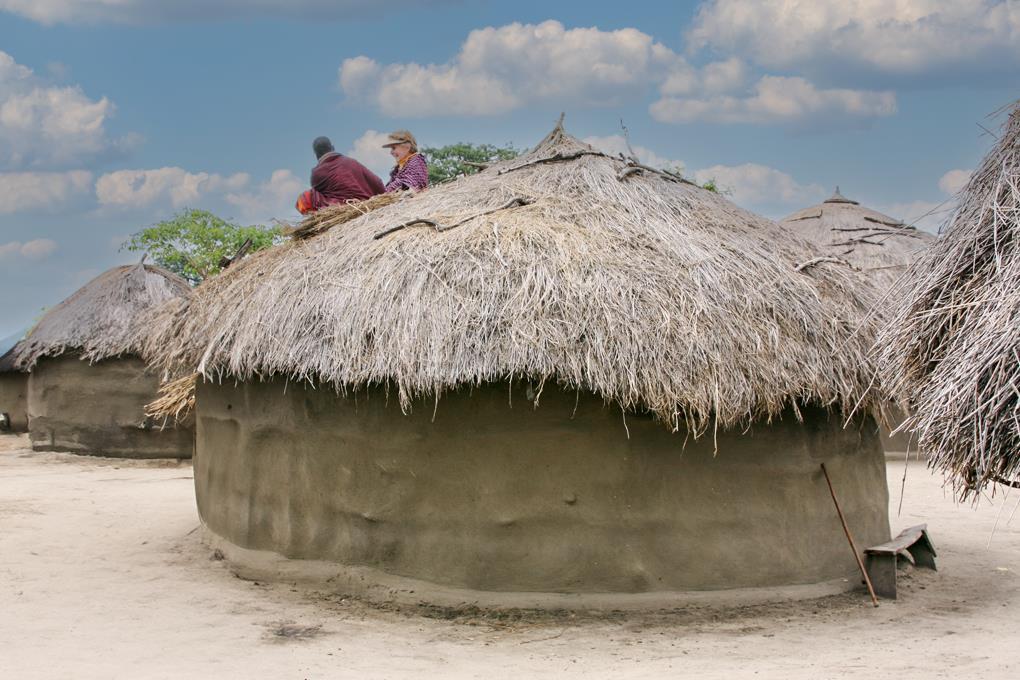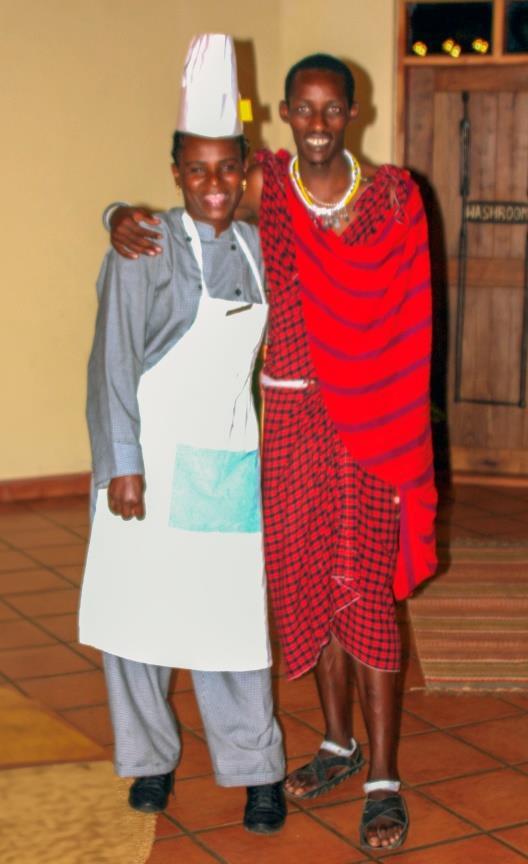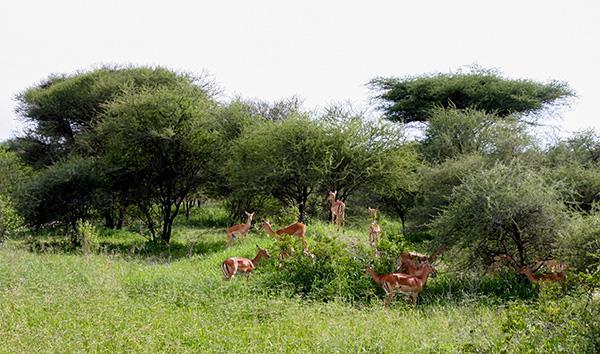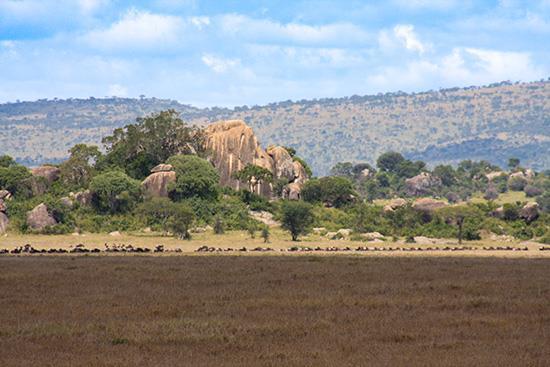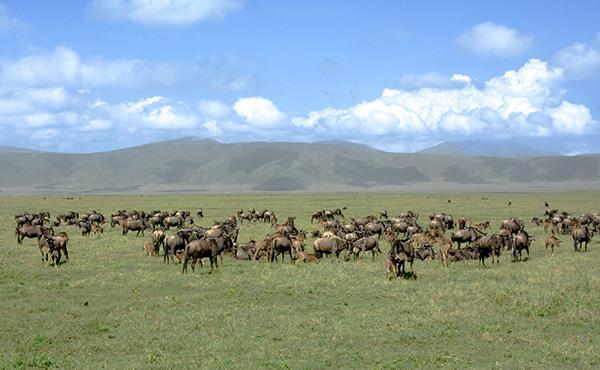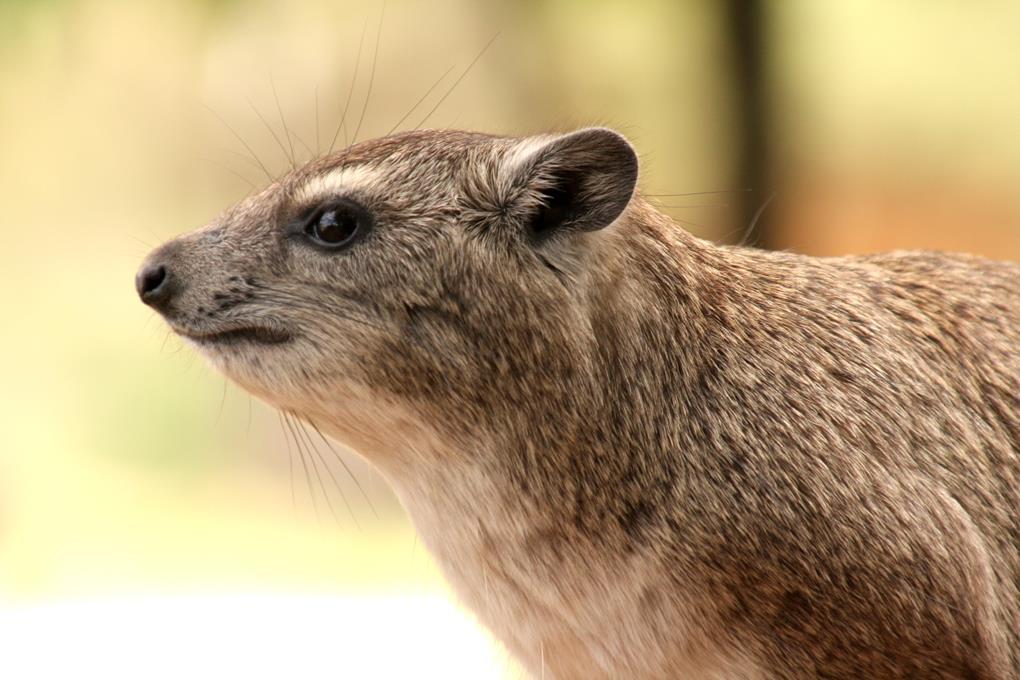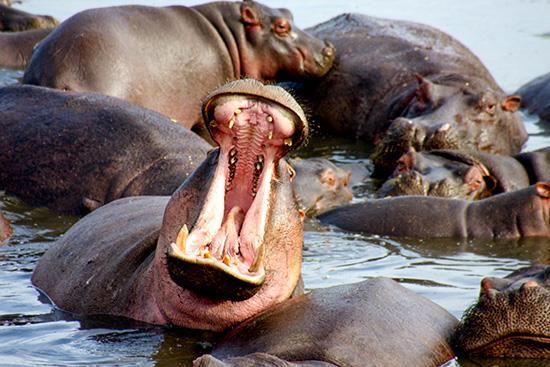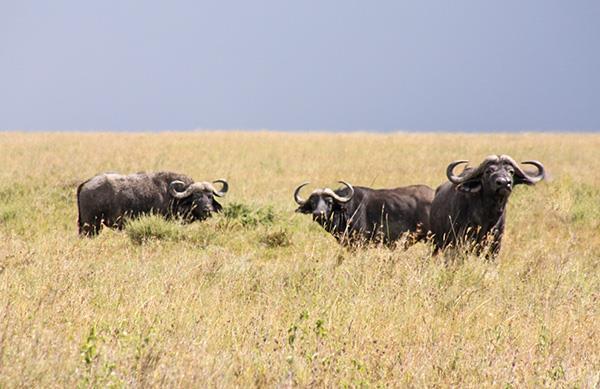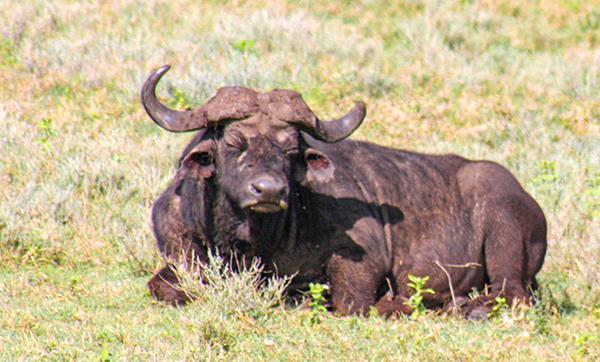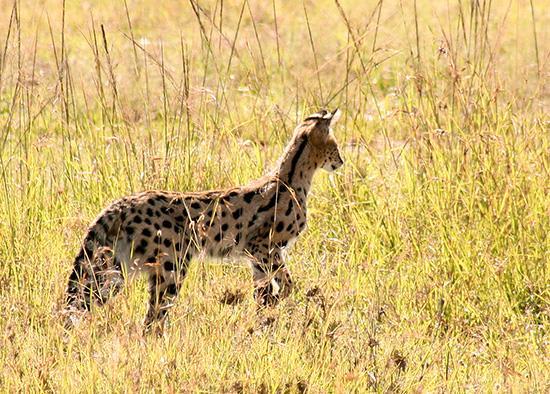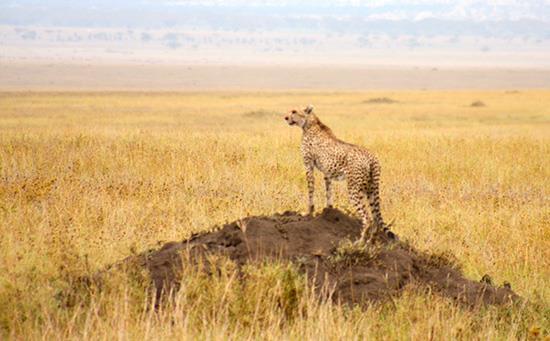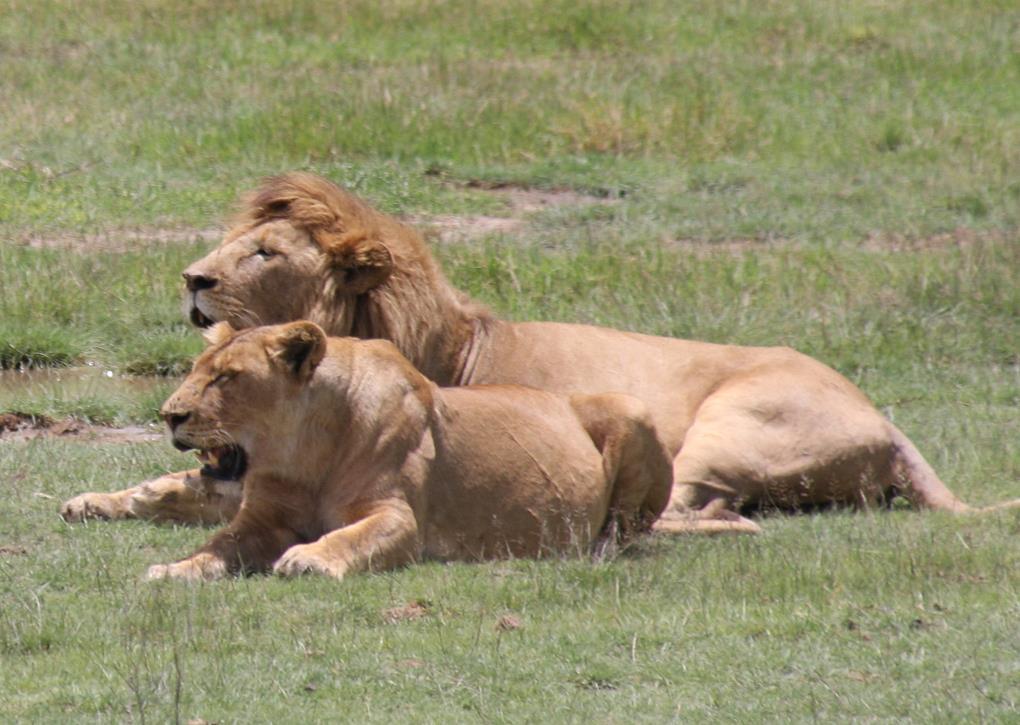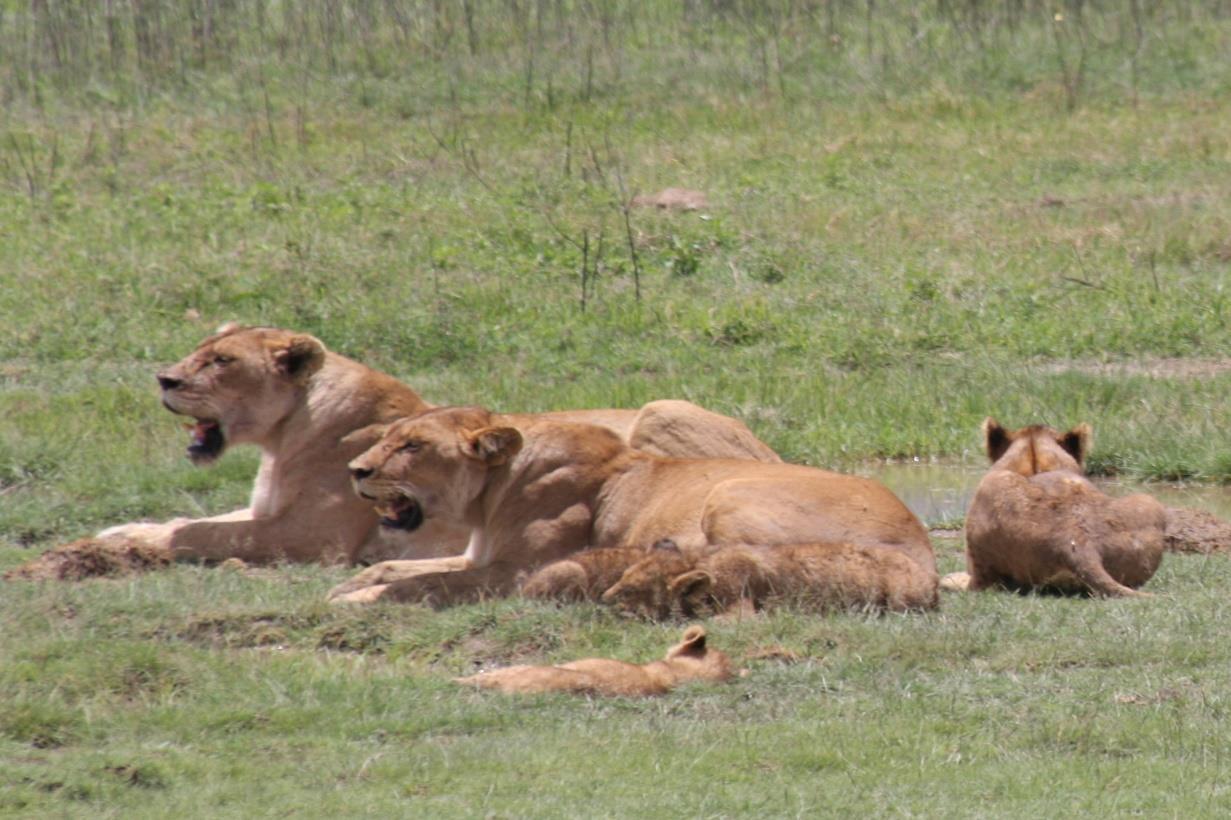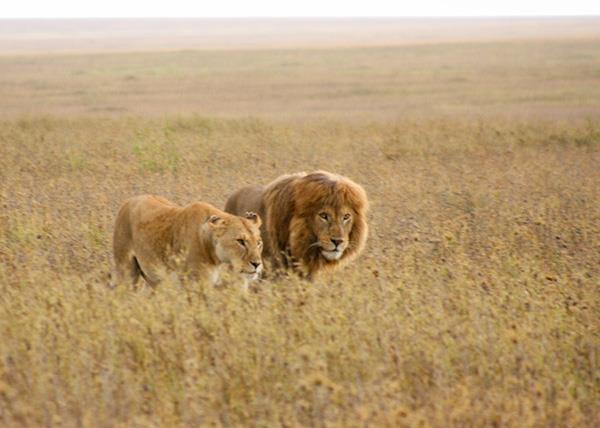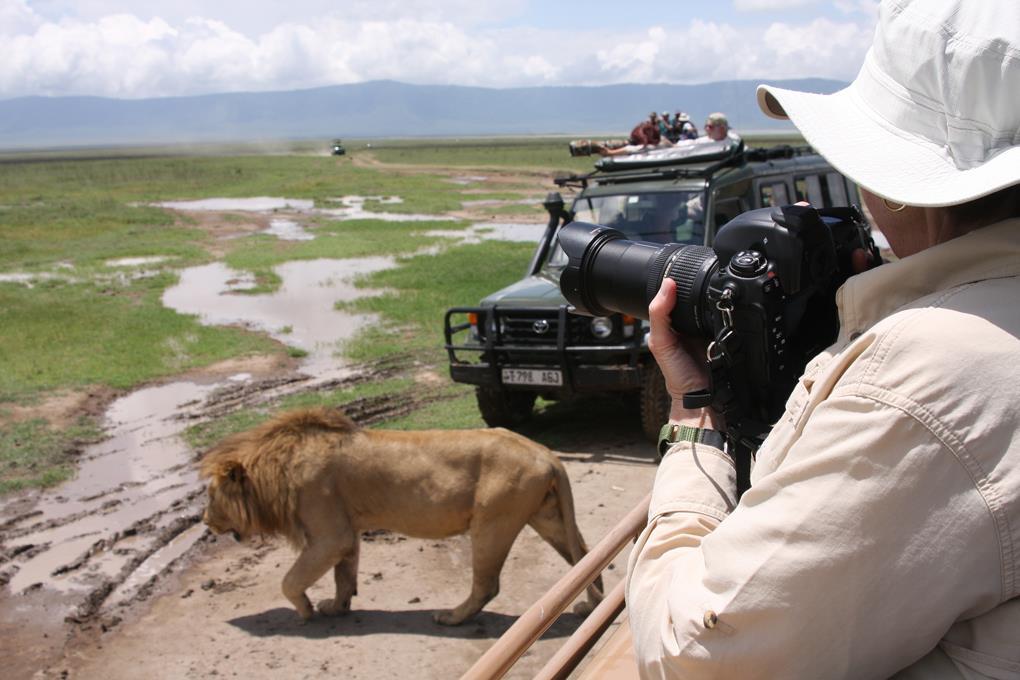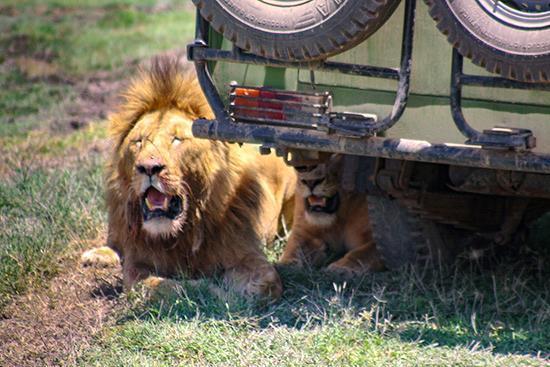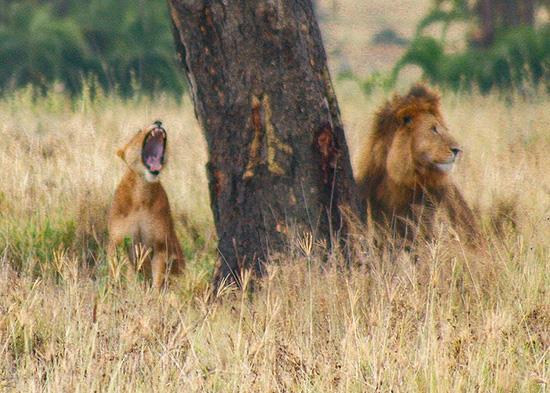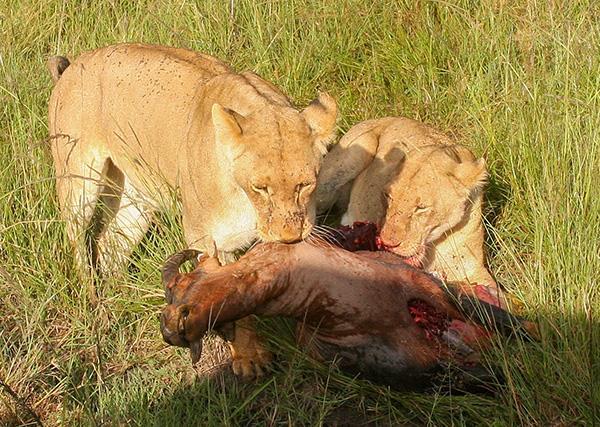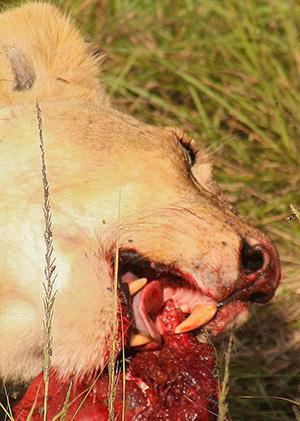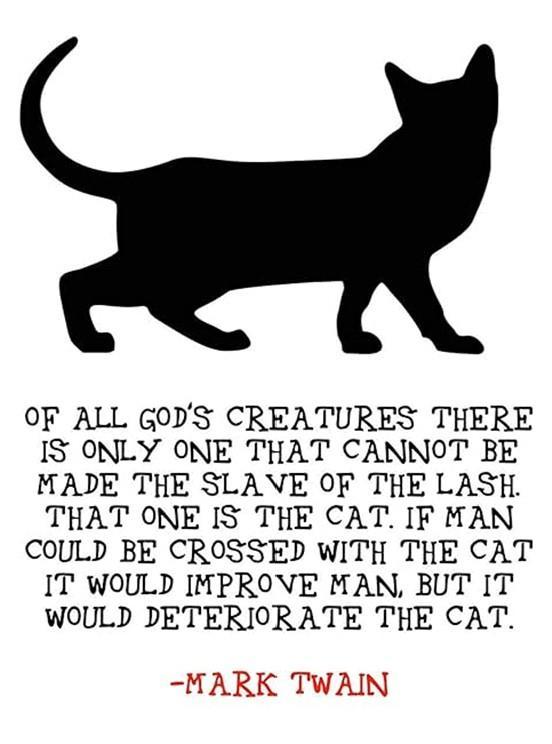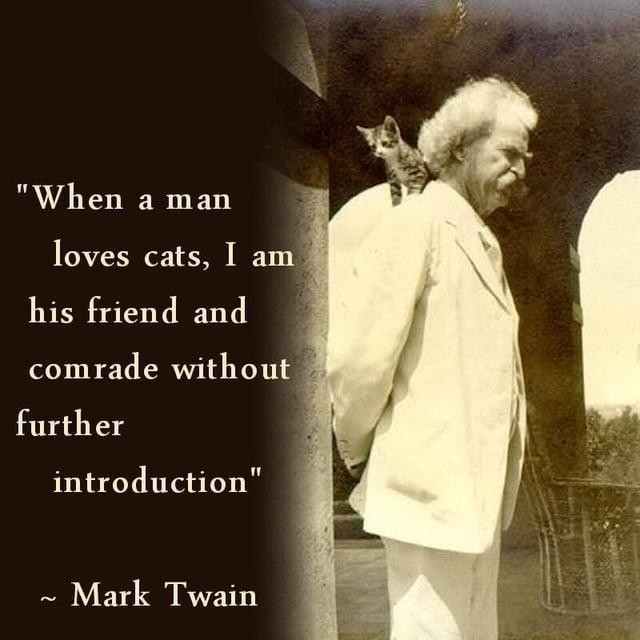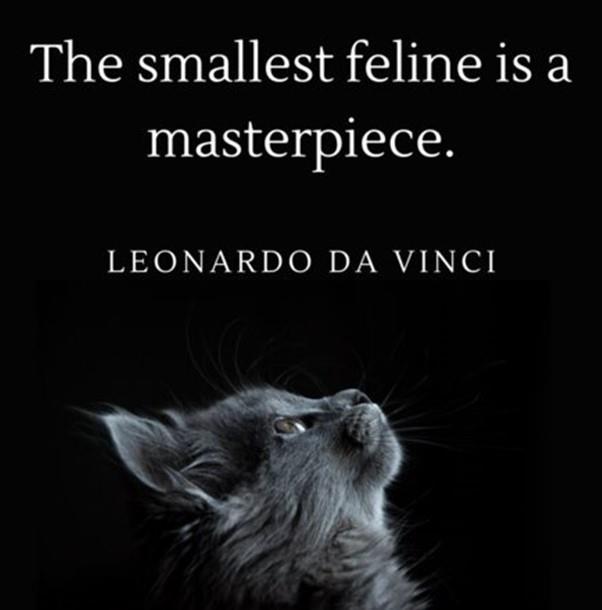AREA
Certainly I had no idea what the Ngorongoro Conservation Area (NCA) or the Crater would look like and I don’t think that the humans knew either at least their surprise seemed as great as mine when we arrived here. The Conservation Area comprises the highlands area which is mixed use, for wildlife and people, the Crater itself, and Olduvai Gorge (more on that later). The whole area is 3200 square miles in size, about the same as the Greek island of Crete. No Europeans are known to have entered the area before 1892 when Germany established a protectorate in this part of East Africa. There is fossil evidence as well as rock pictographs to prove that indigenous peoples visited and lived in the area for centuries. Masai peoples are permitted to live in the Conservation Area, to farm in subsistence fashion and to graze their cattle, but they cannot use the Crater itself for any of these purposes.
The Crater is the central part of the NCA and the real reason for its existence. The Crater is the largest unbroken, unflooded volcanic caldera in the world. It was formed by the explosion and collapse of an enormous volcano (estimated at between 15000 and 19000 ft high) about 2-3 million years ago. The walls of the caldera completely enclose the 102 square mile floor. The steepest wall is
2000 ft high and sits facing easterly trade winds where the 25 inches of annual rainfall supports montane forest. The lower western wall (about 1000 ft. high) receives around 13 inches of rain annually and nourishes the grasslands which cover the floor of the crater, punctuated only occasionally by a strange tree (acacia xanthophloea) which is one of the few in the world which conducts photosynthesis through its bark rather than its tiny leaves. This is also the same tree the British labeled “fever tree” because they believed that something exuded by the tree caused a disease characterized by high fevers. The truth actually turned out to be that the trees grow where there is water and the tsetse fly enjoyed living in that environment among those trees.
Besides good yearly rainfall, the crater is supplied with water through various streams and many springs. In the center of the crater is Lake Magadi, a salt lake, which is used by flamingoes and other birds who eat the salt shrimp and algae living in the saline waters.
Because of the abundant water and plant life, most animals in the Crater do not migrate out of their paradisiacal bowl. The predators have plenty of ungulates to make their meals upon, the grass-eating animals can dine on nutritious grasses all year long with no need to follow the rains which renew the grasslands in others parts of East Africa. For the hoofed animals, this is really paradise seemingly without end. For the predators and other animals with naturally small populations (like the black rhino), the “forever” part may not hold. Why?
Because the genetic pool is so small when the populations are limited in numbers. When there is too much interbreeding, diseases, structural abnormalities, genetic disorders and other liabilities begin to enter the population causing them to become unhealthy. That can lead only to extinction finally unless a way to enrich the gene pool is discovered. At present, lions, cheetahs, rhinos, leopards living in the park will eventually face the dire consequences of this easy living now.
Our accommodations were very comfortable. The Tloma Mountain Lodge raises most of its fruits and vegetables on site. Meals were excellent and nutritious.
OLDUVAI GORGE
This famous site where Drs. Richard and Mary Leakey discovered the fossils of the earliest ancestors of human beings is also part of the NCA, protected like the Crater and the highlands. The Gorge is an area that closely resembles the American Southwest. It is brutally dry and hot and massive natural erosion has revealed layers of soil, clay, rock that outline the geologic history of the area. Those erosional layers are what attracted the Leakeys here for their archeological digs bones of animals could be seen in the layers and later tools and bones of early ancestors of Homo sapiens were discovered too. The native guide in the Olduvai Museum wanted us to understand that the name which has become famous is actually incorrect. The real name of the gorge is Oldupai, for a desert plant the sisal, which can survive in this area. A German translator misheard the name the local people called the gorge and that is how the misnomer entered the history books. I also learned that the true story of how the Leakeys decided on their digs at the Gorge is connected with one of my ancestors rather than those of smug and self-important human beings. As the story was told to us, the Leakeys met a native man who was carrying around a saber-toothed tiger incisor showing it to anyone interested. It immediately caught the attention of the Leakeys who eagerly asked where he had found it. He took them to the Gorge! Hah take that Homo sapiens! See who was there first?
Had to get that in, just couldn’t resist! However, the real topic here is where we stayed to explore this marvelous region of Tanzania. It was the lovely Ngorongoro Farmhouse perched on the high side of the crater. The farmhouse with its adjacent duplex motel type rooms for guests was nestled at the center of a real working farm which produces coffee, tea, vegetables, dairy products, fruits and flowers for the guests and employees of the resort. The view from the rooms was spectacular down and across the Crater with mountains falling away in oceanic waves from the hillside farm. Sunsets were amazing. The food was gourmet with the “stylings” of the incredible Veronica, a graduate of “cordon bleu” cooking school in Dar Es Salaam (capital of TZ) and Zanzibar as well as her own self teaching. Her meals were really a special treat, with a wonderful fusion of French and African styles, featuring all those fresh carrots, lettuces, eggplants, beans, tomatoes, broccoli, celery and marvelous arugula. Just superb! And who would have expected excellent crème brulee in an African farmhouse?
Of course, staying here was not roughing it at all! The only enduring sign that we were in a foreign country was the ubiquitous mosquito netting around our beds. We were able to explore the gardens and also the fields where the corn and wheat were grown in larger plots. We had reliable power and were still in the land of the flushing toilets. The very ambitious and rich Papa Wilson is the owner of this lucrative enterprise as well as others (including the tour company we were using Kibo Travel and the Olasiti Lodge where we stayed in Arusha). He is half Masai and half German and seems to have an unusual extension to his right hand a wine glass which we never saw him without, regardless of time of day or night, nor was it ever empty.
THESERENGETI
Ah, the golden dream of any African visitor! The Mecca for those who want to watch animals in the very web of life that Mother Nature created. There is little human interference with the timeless behavior of the creatures the migrators who follow the seasonal rains and tender grasses, the great predators that prey upon them, the wide vistas across which innumerable animals can be seen. Immense skies and magical clouds roof the scene. On display also are the courting and mating rituals, the new babies born to continue the endless cycle. Above, the great birds of prey that wheel overhead and the countless little colorful ones that dart and flicker among the bushes and widely separated trees. Impossible to describe in words or even to capture completely in photographs, but also not possible to forget once you have seen it!
The nomadic Masai named this area with their word “siringet” which means “endless plain.” You have only to stand in the range rover and look all around you and understand the accuracy of their label! But vast as the grassland is, it comprises only 1/3 of the park. The other 2/3 is in woodlands and bush. Again, the tsetse fly protected the Serengeti from human depredation since sleeping sickness was the “gift” of the insect. Therefore the magnificent park was relatively untouched except for the European penchant for hunting.
The Serengeti is the offspring of the great volcanic eruption that formed the Ngorongoro Crater. Ash from the stupendous explosion and collapse was blown over onto the rolling landscape and created a rich soil for the support of grasses and animals. Analysis of the plants here has proven that they are
the most nutritious in the world because of this soil base. Even early in Colonial times it was recognized that this special environment needed to be protected and a Game Reserve was declared in 1929. In 1951, the reserve became Tanzania’s (then Tanganyika) first National Park. It protects 5700 square miles of this unique ecosystem, while the rest of the area (11,583 square miles) is protected by other parks, games reserves, the NCA and Ngorongoro Crater, and Kenya’s Masai Mara.
The entire Serengeti ecosystem sustains the largest animal migration system on earth. No permanent structures are permitted in the park or its environs. So how did we get to stay in the park for 4 magical nights? In a wonderfully wrought mobile tent campsite. Even mobile tent camps can stay in one place only 30 days (by permit through the park management) and then it must be moved. No changes can be made in the landscape, such as smoothing the land beneath the tent, or the cutting of trees, or removal of bushes. No pit toilets can be dug, no trash buried, no marks upon the land in other words. So these clever folks have devised a way to set up the tents without any disturbance to the soil except for tent pole holes. That means the floor of your tent is very lumpy and bumpy. Your bathroom area in the tent is quite ingenious; the shower comes from a bucket hanging over your head with the water discharge controlled by a lever. The toilet was a regular “throne,” set upon a raised boxlike affair under which was a tank into which the toilet “flushed.” The waste water was collected and trucked out of the park proper for eventual disposal.
In the mornings, the tent steward came by to awaken us at the appropriate time for breakfast and the day’s activities. He also brought with him a canvas basin of warm water for washing up after the night’s sleep. That was quite a luxury! The “basin” sat on a tripod of metal legs which held it quite steadily unless you leaned on it, like Lois tried to do to put on her shoes. That did not work at all and the water spilled all over the front “porch” of the tent. She only made that mistake once. The porch of the tents was created by an overhang from the fly and a ground cover for the floor.
Even the campfire site had to be returned to its original condition after we left the area. We took our meals in a large mess tent and they were really plentiful and delicious. We all wondered how in the world such variety could be accomplished. We had fresh baked breads, meat dishes, vegetables, rice and/or
potatoes, even cakes and puddings for dessert. Before we left camp, we requested a “kitchen” tour and it was really fascinating and ingenious. The “oven” was a large metal box with two shelves within it. The items for baking were placed in side and the box (about 4 ft. long, 2 ft. deep and 3 ft. high) was placed over the charcoal fire. In about an hour, our excellent Chef Joseph opened the oven and the whole camp was filled with smell of fresh bread or a delicious cake. He had big cauldrons for the soups and veggies, and he could prepare the meats in various ways some over the charcoal fire, some on hot plates for sautéing, frying, and steaming. There was a generator to power the refrigerator and that explained the variety of foods.
The power in the camp was supplied with solar panels. Even the lights in the tents were powered by small solar panels that lay on the grass outside each tent. The whole panel was about a foot long and 6 inches wide. The three lights in the tents were very faint, but sufficient to get dressed and undressed by. However, they were not bright enough for reading! The beds were cots with extra padding on them and plenty of blankets since it got surprisingly cold at night, even after the very hot days under intense sunshine. Our day temps would get into the 80s unless there was overcastness and at night it go to almost freezing.
We did get some of the rains expected during the rainy season while we were in camp, but the tents were quite watertight and we had no drops on our heads. You know I would have really hated to be dripped on.
KENYA MASAI MARA
As I mentioned before, this park is the northern extension of the Serengeti Plain and this was the only one we visited in Kenya. It is a beautiful park which demonstrated that the rainy season had started earlier in Kenya. The grasses were greener and taller and the animals were happily staying on the plain rather than following the storm clouds and the smells of rain as they were in Tanzania. At only 583 square miles, Masai Mara is not the largest of Kenya’s national parks, but it is certainly the most famous, chiefly because of the 20+ lion prides living there. Now that’s what I wanted to hear and what I cam to see !
Our home in this park was a permanent tent camp named for the most numerous creature in the Serengeti and the Masai Mara: the wildebeest, Nyumbu in Swahili. And this camp was definitely the most luxurious though it did have a couple of interesting features. It is a large camp with at least 20 tents and all connected with a concrete pathway made to look more authentic by embedded stones from the area. The tents are large and rather similar to those in Maramboi except that these are covered with canvas flies rather than thatching. Big bedroom area, a separate shower room, and a most interesting toileting facility. This is the one that really appealed to me since it was rather like home. My humans got to try the sandbox experience. The toilet looked conventional, but rather than having its bowl filled with water, this one sat over a metal bucket which was filled with sand. Next to the toilet was a plastic bucket of sand that you used to cover whatever you had added to the toilet “bowl.” Actually it worked very well (as I could have told the skeptical humans) because covering everything with fresh sand prevented any odors or anything else unpleasant.
Nyumbu was fully electrified but showers were the same bucket type arrangement we had experienced in the Serengeti Mobile Camp. Here we were brought the basins of warm water in the morning as well, to get the day off to a good start. The dining area was more “formal” than in the other camps and the kitchen proved to be quite modern: gas refrigerators, real ovens, really big hotplates, and grills. Chef Peterson here was every bit as talented as our earlier camp chef had been. The food was simply wonderful.
The meals were served buffet style different from the other camps where we were seated at long tables and the food was brought to us.
The site of this camp was terrific as well because we were situated by a little stream across from which was a rocky rise where a pride of lions often slept the night. That was pretty exhilarating, hearing them roaring and “coughing” so close they seemed to be right outside that thin canvas wall, only separating us from their big teeth. I really loved hearing them and I wasn’t scared at all because I figured if one of the females actually came into the tent, she would go for one of the humans rather than me I’d be such a skimpy meal I wouldn’t be worth the effort!
WHOWEMET
This chapter will be limited to the human beings we encountered because we did not actually “meet” any of the animals we observed. As always, humans are amusing to observe since they are so various in their behaviors, their cultures, their individual appearances not to mention their traditions. So unlike us felines who are so admirably consistent (even predictable), stable and equable in our temperaments, and so readily identifiable in our outward presentations. In other words, one lion looks pretty much like another, except to another lion perhaps. And he has a range of readily perceived and easily observed behavioral patterns.
Personally, I think that this consistency is a mark of higher evolutionary development. But, I digress; I want to get on with my people observations.
Our Tanzanian Guides
Ronald, Eric, and Morgan were all personable and interested in making us feel comfortable and happy with our experiences. One of fascinating things about them as a group was their identification with their personal tribes, but their tolerance and liking for each other despite that difference. More on that point later because it seems to be a big reason why Tanzanians have not fallen into factional squabbling and murderous hatred even though there are more than 120 separate tribes in the country, with different languages and cultures.
Ronald, the tour leader, was fairly new at the game of leadership and had a few problems with his management style, but he also made everything happen as planned and without visible effort on his part. He was a little wordy at times (probably due to the influence of the Africa storytelling tradition which champions long, drawn-out shaggy dog stories), but his good will shone through and his determination to please his boss in Arusha was usually the cause of his hesitations and lack of originality.
He had thoroughly learned the OAT philosophy and what was expected of him and he was not confident enough to deviate from the “OAT way.” Withal, he had a good sense of humor and clearly liked his guiding job, was proud of his
guiding skills, and enjoyed being around people. He liked to tease but could also take teasing aimed at him. Our little group believes that he will make a go of this promotion, given a bit of time to gain confidence.
Eric was the most outgoing of the three Tanzanians and he smiled broadly and often. He could be moody, however, and most of his more sulky periods could be attributed to his impatience with Ronald’s leadership style. Sometimes, he would retreat and refuse to participate in campfire discussions, but we understood his frustrations because Ronald so rarely left either Eric or Morgan much to say. In the range rovers, though, he was always pleasant and proud of his knowledge of the environment and the animals. We travelers often “needled” him about his heavy foot on the gas pedal but he rarely slowed down. However, he did not speed through game drives and animal watching. He was patient and methodical in those situations. Eric seems to enjoy being a guide and does work to make the visitors have an enjoyable experience.
Morgan was the newest member of the OAT team and he was probably the most knowledgeable about the ecosystems we visited. He was quiet and reserved but forthcoming and generous in sharing his knowledge and experience in the bush (with other companies actually). He too seemed to chafe under Ronald’s management style but he did not sulk in the same way that Eric would. He did not often participate in campfire discussions either, but that was mostly due to Ronald’s conversational style rambling and longwinded, leaving nothing further to add.
Observing Morgan at the Masai village was quite fascinating. Here we were to be shown the traditional bloodletting procedure the Masai have been following for centuries to obtain the blood from their cows. Most of our group went readily into the kraal (corral) where the cows were penned, but a few of us stayed outside not wanting to see the custom. Morgan stayed outside with us, but he was obviously disturbed and even a little piqued at what he perceived to be our disapproval of the practice. Judy, a child psychologist, observed his manner and responded to his confrontational questioning about our motives. He posed questions, “What would you do if you were the only survivor of a plane crash and were starving? How would you feed yourself? Would you starve rather than drink blood?” Judy immediately understood he believed we were condemning the Masai practice of drawing blood from their cows.
She told us directly (and Morgan indirectly) about work she had done with seriously ill children who had to undergo numerous blood-draws and treatments. The group had discovered that the children exhibited behaviors in response to the unpleasantness which could be separated into two approaches. Some children were “attenders” (the word the psychologists applied to their behavior) and wanted to be told as much as possible about the impending procedure and then wanted to watch the whole thing. The other group was labeled the “distractors.” They wanted to know as little as possible about what was going to happen and they wanted to be told stories or engaged in little games while the injection proceeded. They always looked away from the puncture site. Children as young as 18 months exhibited one of these behaviors and after several years of observation rarely ever changed their approach. She smiled and said she guessed that those of us standing outside the kraal were the “distractors.”
Morgan had listened thoughtfully throughout her story and then asked her to define the two terms more explicitly for him. She did so and a cautious small smile of understanding clearly showed that he was thinking about it and had never thought of it that way before. Judy then clenched the explanation by saying that we “outsiders” did not condemn the Masai for their method of gaining protein, we just didn’t want to watch it. Morgan seemed to understand us a little better (and we understood our own reluctance better too). I think he forgave us our cultural faux pas afterwards.
Of course, the irony of the whole situation lies in the fact that the bloodletting procedure the Masai utilize does not seem to hurt the cow at all. The cow whose jugular was penetrated by the arrow never bellowed or whimpered. It barely even flinched. Cows are treasured animals in the Masai culture and their prestige in their own society is measured by the number and health of their herds. They care for the cattle diligently and little Masai boys from about three years and up learn to tend the herd, protect it from predators, and from other dangers. Of course, they do eat the meat of the cattle but not as often as we slaughter cattle for our food.
The Tanzanian Crews
Though we did not get to “know” them really, all the people who worked hard to make our trip so memorable were welcoming, friendly and unfailingly helpful. Big smiles always greeted our appearances at the dining tables, in the main lodges wanting something to drink, at our tents when we asked for showers, even walking us back to our tents in the darkness at the various campsites. Naturally some of this is training for the tourist industry, but nonetheless, we all felt that the Tanzanians are a happy people who appreciate visitors from other cultures and enjoy their work. Our own friendliness helped, we are sure. Our group was not demanding and unreasonable and, from what I observed, unfailingly polite and appreciative of the crews’ efforts on our behalf. I was reminded of a little poem by Matthew Arnold about the occasional behavior of cats and I endeavored never to be perceived in that way by the friendly Tanzanians.
“Cruel, but composed, andbland Dumb, inscrutable, and grand So Tiberius might have sat Had Tiberius been a cat!”
Our Fellow Travelers
Our group of 15 was quite compatible and none of them objected to my presence on the trip; of course most of them did not know I was along. They will be surprised to see Kay’s DVD which will reveal that I was there all along, enjoying everything as much as they did. After all, as the wise French author, Colette, observed, “Time spent with a cat is never wasted!” Also instructive about human relationships with cats is an old proverb “You will always be lucky if you know how to make friends with a strange cat.” And absolutely to the point is Robert A. Heinlein’s belief “How you behave towards cats here below determines your status in heaven.” Hear, Hear! I say.
The Ebullient Mama Anna
The big adventure of the first day in Tanzania was the trip up to Mama Anna’s. What an adventure it was for the humans, but I hated it. Being jostled and thrown around in a van is not my idea of something fun or dignified. The narrow
red clay, stone sprinkled, rutted way up the shoulder of Mt. Meru was not what I’d call a road at all. The van vaulted, slipped, jumped, halted and lurched its way for about an hour and all the time the humans were laughing and joking while I was constantly picking myself off the floor of the van or trying to get a purchase on someone’s lap or the car seat. Strangely enough, no one wanted to let me get a good hold on their legs with my claws so I could stop all that falling around. Even my own humans were callous about my efforts to get a secure perch. Sometimes they even screamed and slapped at me I wondered what had happened to these creatures who are usually so considerate of me. Their loud noises added to the general discomfort of the trip too. You know, we cats are quiet and react poorly to loud sounds!
Oh well, we finally made it to the proposed destination despite all the pitfalls. However, I wished they had left me behind at the lodge where I could have examined every enticing flick of a tail or wing in complete comfort.
This was definitely an experience for humans only my feline sensibilities couldn’t have been less interested. However, here’s a brief report anyway just for the sake of completeness
Mama Anna is an enterprising entrepreneur who has created a business for herself and a small community of other ladies to support their families and contribute to their school and health care facility. She taught herself to make cheeses in the Swiss manner and supplies local restaurants during the dry season when her product can be brought to market down thatso-called road.
During rainy periods, it is just about impossible to get her products to market. She and the other ladies also raise coffee and process it themselves for local sale. Vegetables are grown as well and the ladies take those to the
restaurants and local markets as well. Her most ambitious project however is the linkage she has created with the tourist industry, her best client being Overseas Adventure Travel.
OAT pays her little cooperative to demonstrate the methods of coffee processing, cheese making, and other crafts for tourists who come up to visit. The humans were served some goodies made with Mama Anna’s products as well as tea and coffee and were given a taste of the wild honey they take from their own apiaries.
The ladies do not risk working with the infamous “killer bees” of Africa; instead, they provide homes fashioned from split logs that attract a gentle stingless bee. The honey tastes as if some spice like cinnamon has been added (but nothing has been) and it is not as sweet as the honey we are used to at home.
We learned an interesting cultural factoid from our visit to Mama Anna’s women in Tanzanian society are always given the honorific “Mama” when they reach adulthood (rather like our Ma’am perhaps). Once they have a child, their full title includes the name of their first born, regardless of sex. So Mama Anna’s first child was named Anna and if her first had been a boy named William, she would ever afterwards be called Mama William.
The ladies of our tour group were outfitted in typical African sarongtype garments, patterns so vibrant with flowers and birds the pupils of my eyes went all “slitty.”
Then they were shown how to pound coffee to remove the outer two shells, then how to roast it, and then how to grind it into powder. They all took turns trying to master these skills.
Some of them took a turn at churning milk into butter. (I thought what a waste of good milk kept hoping some would leak from the churn, but it didn’t and I was getting thirsty too but in Africa cats are supposed to earn their keep—no freebies for me.)
Mama Anna and her ladies also demonstrated how the elegant African ladies carry such heavy loads on their head with such grace. They balanced bananas “hands,” water buckets, wood, and trays to the great appreciation of our group. Then the intrepid ones tried to imitate the skills with varying degrees of success but with much laughter all around.
Mama Anna and her ladies were so warm and welcoming everyone enjoyed trying some African dances and learning about her ambitious project. We all wished her well but wished that she were not so dependent on tourism which can be so unreliable. Economic downturns affect it as does the whim of the tour directors and guides. Mama Anna needs a local customer base for her products, letting tourist visits be her gravy rather than her meat and potatoes.
The Datoga People
Among the many tribes of Tanzania who have rejected westernization most completely are the Datogas. They still live a nomadic lifestyle (while even the Masai have become pastoralists rather than nomads) with temporary “villages” set up as they find good pastures for their cattle (Zebus), sheep and goats. We visited one of these villages while we were in Tarangire National Park. These folks (about 30 counting children) had set up a “boma” (temporary village site) near the border of the park and welcomed our visit (they were paid for their hospitality by OAT, but their friendliness and warmth was above a purchase price).
Upon the open grasslands, their boma was circular with the boundary created by heaping up piles of dead thorny acacia branches. The entry to the village was stopped at night by pulling more of the branches into that opening. Inside the circle were huts, even that term seems too sophisticated for these dwellings, and inside the ring of huts lived the animals during the night when they must be protected from the wild predators always eager for an easy bite. This arrangement means that the ground upon which the people walk in their village is a mixture of cow, sheep and goat dung with the
clay soil. They live in their own and their animals’ excrement. Because of this, the most salient feature of their lives is the presence of flies—flies everywhere, on heads and in hair, around the eyes and nose, clustering on the lips, clinging to the napes of necks, alighting on clothing! While we felt our flesh creep just looking at the people, they are so used to the presence of these insects that they never raise their hands to swat at them or wave them away.


The huts, made of sticks and mud, are more like dormitories. The men live in one long structure and the women in another. Wives of the chief are granted their own small hut for themselves and their young children. When the children reach about 6, they move into the appropriate dormitory for their sex. If the wife has no young children at that time, she moves into the women’s dorm until she is pregnant again. The huts are dark and smoky inside, with no windows, just holes to let in light. In the heat of the day, these homes are stiflingly hot. No wonder everyone is outside during the day, even in the sunshine.
There are very few trees on the plains and the bomas would not be built near them anyway because it is safer for the village to be completely out in the open. That way the warriors can see predators coming a long way off.
The Datoga have not embraced education as a way out for their children and have resisted attempts to bring them into the modern age. Their traditions are important to them and they do not want to lose their cultural identity. Because family groups tend to live together but separate from other families most of the time, it has been difficult for modernizers to approach them and make any kind of headway in demonstrating the advantages of modern farming methods or technology of any kind. Their health care is non-existent and they live in a deplorably unsanitary condition, yet they endure.
The Masai have been their hated enemies in the past and though peace reigns between them now, they are not persuaded by the advances the Masai have allowed for themselves. The Masai were fierce warriors who persecuted the Datoga and drove them from their traditional pasturages over and over. No wonder they don’t particularly like or trust them today.
The Tanzanian Masai
We first encountered the Masai through a visit to one of their villages not far from the Datoga encampment we explored. What an enormous difference between the two cultures. There is a superficial resemblance in the appearance of the two peoples in that the men wear red blankets tied at the shoulders and carry spears or sticks always. But there the likeness seems to end. The Masai Village was clean, the yards between the huts were swept clean of debris, the cattle were housed in kraals away from the human living areas. The women wore bright clothing and much beadwork of their own creation. The men did wear the red cloths and also adorned themselves with lots of beadwork jewelry.
They look the part of a proud people accustomed to being treated with respect.
The site we visited was the home compound of a single man and his 4 wives.

Each wife had her own home where her children live with her until they are about 7 years old. This is another similarity between the Datoga and the Masai. The women’s houses are round and built of wood and dirt. The outside is “stuccoed” with mud and cow dung and designs are painted with subjects including birds and flowers and animals. The inside is rather like a nautilus shell with walls within the circle. Though there are no windows in these homes either, they seemed much lighter inside because of many penetrations in the walls. The inside walls are also painted with designs by the lady of the house. The houses include sleeping quarters, a cooking area, and a separate room for young animals who need special protection in the night. There are benches and stools around the walls of the home. The top of the mushroom shaped building is made of thatching. The women do all the building, the stuccoing and the thatching themselves (with help from the other women in the family) and also do the maintenance on the building.
The men of the village provide the physical protection for their families and care for the family’s wealth—the animals. Some villages include dogs and cats, who are working members of the community. The dogs bark and provide advance
warning about approaching predators. The cats keep down the vermin like rats and mice. These animals are not “pets” however. (I felt a little sorry for them because they often looked poorly fed and a bit mangy.)
While the men of our group sat around and drank homemade hooch with the father, father-in-law, and sons of the village, we women were asked inside the first wife’s home for a little conversation and a very provocative Q & A about married life. Ronald was our interpreter. At first the conversation centered on family life, marriage customs and children. The Masai women were genuinely surprised and a little sympathetic with American women who have only one husband.
The first wife even said that she liked the fact that her husband had three other wives because that meant he didn’t hang around her house that often. She asked the Americans how they put up with having the husband always with them?
The married women were asked about their children and grandchildren and the more children they mentioned, the louder the Masai ladies cheered them! They were so happy for the American women with many children and grandchildren. It was a different reaction altogether when my humans, Lois, Sharon, and Betsy said they were not married. That elicited questions concerning widowhood. When told that was not the case, the ladies still asked about children. They were quite shocked and saddened when the three ladies admitted they had no children either. They asked who would take care of us when we could no longer care for ourselves. The first wife asked Sharon why she was not married and Sharon lightly answered perhaps she was too ugly. The first wife would have none of that she told Sharon she was too pretty not to be married and said she would find her a husband easily! It was clear that for Masai women marriage and children is the purpose of their lives and they felt real sympathy for those among us who were not married.
Kay had quickly realized that our answers had made the atmosphere in the home somewhat dejected so she answered that she was married and had three children. This cheered the ladies up considerably. One of our group tried to explain that in the US women have many choices that can result in meaningful lives, but that was completely beyond the ken of these sweet and sympathetic ladies.
The question of female circumcision was raised with us and that was surprising indeed. The first wife said that though the practice is actually illegal in Tanzania, many young girls want to be “cut” because after the procedure they are considered more desirable marriage candidates. Many young girls request their parents to provide the means for the procedure.
Ronald, our interpreter, told us there are now shelters where girls not desiring circumcision can go to avoid it if their parents and relatives are insistent about it. He even told us the story of one young Masai girl who broke with tradition and ran away to the shelter, risking the condemnation of her family. The shelter sponsors insured that she received an education and later she returned to her village to teach and eventually to provide leadership in the village. She became a very respected personage; however, she never married.
One of the ladies sitting next to Lois leaned over to her and quietly asked if she had been “cut.” When Lois answered in the negative, the lady was even more sympathetic about her unmarried state because now she believed that she understood why Lois had never married.
Though the topics could have been considered intrusive or inappropriate, none of the ladies in our group resented their being raised or felt affronted by the responses of the Masai women. Instead, we all felt that the conversation had helped us understand Masai culture a little better though we are not at all sure that the Masai ladies understood ours any more than they had before.
Our Masai Waiter
When we stayed at the Farmhouse Lodge in the Ngorongoro Highlands, we met our next Masai. Joseph was a waiter at the Lodge and he met us for our first meal there in his full regalia. He looked totally regal and not at all
like he should be waiting on our table. He was tall and slender and completely covered with the beautiful beadwork necklaces, bracelets, and earrings we had seen in the village visit. He even demonstrated the amazing jumping ability of the Masai men one evening after supper. He was an excellent waiter and took pride in his work. He worked very well with the head chef, Veronica, in presenting the food and serving it.
The Schoolchildren
One of the delights of OAT travel is the opportunity to visit schools that OAT supports with money from trip fees. Our visit to the Bashay School was no exception. The Grand Circle Foundation (owner of OAT) has been helping this school for at least 7 years. The Foundation helps with classroom construction, school supplies, even teachers’ salaries. The money is sent to GCF managers in Arusha. The managers survey the needs of the school and talk with the principal and teachers. Then building materials will be purchased, or supplies bought no money is given directly to the school so GCF can insure that the donations are used for the agreed upon projects.

The Bashay School taught students from first grade to seventh grade. When students complete 7th grade, they must pass a national exam in order to continue their formal education. We were all impressed with the apparent quality of the teaching and greatly enjoyed meeting Mr. Basho, the principal, and the two teachers handling the class of first and second graders and the class of seventh graders. They are obviously dedicated people and are proud of their student’s accomplishments. The principal makes about $500.00 a month and teachers’ salaries range from $100.00 for a new teacher up to $300.00 for an experienced one!
We were greeted with broad smiles and songs when we entered the young children’s classroom and it was impossible not to grin back at these glowing faces. Even I had to twitch a whisker and pull my lips back into a feline version of smiling. The children were mostly dressed in uniforms, neat and clean. Those who cannot afford uniforms are still welcome in class and they too are dressed neatly. The walls of the classroom were filled with children’s pictures, posters, reminders about behavior. We had such fun taking the children’s photos as they sang in English and worked math problems under their teacher’s instruction. Lois was particularly pleased because her Polaroid camera worked and she snapped around the room wanting to get each child into at least one of the pictures that she left with the teacher. As we left the classroom, the children were clustering around their instructor to see themselves in the pictures.
Then we went into the classroom of the students who are studying hard to pass the post-7th grade exams. They were shyer yet still welcoming. They too sang for us, the National Anthem of Tanzania in particular, and they too were eager to see the Polaroid pictures that Lois left for them. We asked them what they wanted to be when they finished their educations and we got some surprising answers. One small bright young fellow responded that he wanted to be a pilot, a shy young lady wants to be a teacher, another boy said he wanted to be an engineer, a surprising young man wants to be a nurse, and an even more unexpected young lady shyly looking down at her desk reported that she wants to be “prime minister” of Tanzania! We all congratulated them on their dreams and ambition and hope they all succeed.
During a brief meeting in the principal’s office, we learned that GCF also supports a secondary school for those students who do not pass the allimportant exams. This gives those youngsters a second chance at further education. That seemed imminently sensible to all of us since children mature at different times. Sad to think their educations must end if they fail to be mature enough or focused enough at the time of the exam. Good work by the Grand Circle Foundation.
Our Leader, James
We were all surprised (maybe even a little alarmed I admit I was; despite my best efforts, my back arched and my fur stood on end) when we were met at the Masai Mara airport that served Nyumbu Camp after flying in from Nairobi. We alit from the plane and two men in typical guide/driver clothing walked up and introduced themselves as Christopher and Morrison. Then from behind them stepped James, our tour leader in Kenya. James was tall and slim, handsome, and outgoing. And he was dressed in complete Masai warrior style. A vivid red blanket stretched across his back and torso and tied on the left shoulder, an assegai (spear) rested naturally in his hand and brightly colored beadwork draped his neck and adorned his arms. He wore a sarong type wrap around his waist and walking shorts under that. His shoes were homemade sandals. His dignity was unmistakable and he was barbarically splendid! Were we astonished? Oh yes! But James proved to be an excellent ambassador for his modernizing tribe and for Kenya as well as a concerned protector of Kenya’s wild places and animals. His command of English was excellent and he had a sense of merriment and pleasure in life that was infectious and enjoyable.
We learned much from James, a Presbyterian convert, with quite modern ideas. At 31, he has one wife and two children, a boy 4 and a girl 3 months old. He told us that he will be quite content with one wife only and that he plans to raise his daughter to believe that she has as many choices in life as he will expect for his son. He does not want her to grow up thinking that her only possibility in life is marriage and children. If she chooses that role, he will be content but he wants her to know she has many other choices. He also wants his son to know that he does not have to become a cattle herder living a nomadic/pastoralist life. James believes that modern Kenya will offer his children many more choices in their lives that he himself has had. However, James has had opportunities that most Masai do not experience he has been to school and college, he has been exposed to Christianity and embraced it, and he has a good job in an industry which is nurtured and appreciated in Kenya.
We loved James’ tactful admonition to us when we discussed with him on our drive into camp what we were hoping to see in Kenya. We said lions, servals, leopards, crocodiles, rhino, and hippos. James said he, Chris and Morrison, would do their best to find these animals for us, using their experience with
tracking the animals and their knowledge of animal habits. However, he said there are never any guarantees for what we will or will not see. Instead, he said, “ Whatever we do see, we will thank Mother Nature!” That was his mantra throughout our four-day stay in Kenya. But the fellows did deliver we saw so much animal life that we were all constantly awed and grateful! My own feline dreams of seeing my relatives were more than fulfilled, they were overmatched!
The Kenyan Village
James introduced us to a village of Masai people whose quality of life was somewhere between the poor Datoga people and the rather wealthy Masai family compound we had visited while in Tanzania. The village boundary was also made of acacia thorn branches and the huts were more primitive than those of the Tanzanian family, but not quite as poorly constructed as the Datoga ones. These homes were circular as were those of the Masai, but instead of thatching, these were roofed with earth mixed with dung and then planted with grasses. Moses, our guide for the village visit, invited us inside the 2nd wife’s home here and it was dark and there was no decoration on its unfinished walls. There were no windows, only holes which had to be closed at night to keep out mosquitoes. There was the same chambered nautilus construction with the anteroom for young animals. The wife had a sleeping shelf and across from it was the sleeping area for her children. A horseshoe shaped cooking area occupied the center part of the structure. Moses told us that only vegetables and grains are cooked inside the home. Meats are cooked outside the house.
These Masai also put their cattle within the circle of huts so that the ground was a mixture of clay and dung, just like the interior of the Datoga village. However, the odd thing was that these people were not covered in flies as were the Datoga. They appeared to be much cleaner in their persons and their clothing as well. Despite the fact that their village was not nearly so clean and neat as the one in Tanzania, the people appeared to be fairly well-todo, perhaps because of their ownership of large numbers of cattle and because of their more regular interaction with tourism.
The men of the village greeted us with a song and dancing, involving much shoulder shrugging and foot stomping. The shoulders hunch forward and
then are drawn back in a sinuous, continuous motion. After the song and dance, they then gave us a demonstration of their amazing jumping ability. The men can jump straight up from a flatfooted start from 2 to 4 feet.
The most athletic (and youngest) men jumped high enough that the bottoms of their feet were at the height of the other men’s waists! It was truly astonishing to see. They were almost as talented at jumping as I am!
After this demonstration, the men did NOT ask us to try to jump with them so we were all much relieved. After the house tours (we were divided up so that only two people went to each house at a time) and then we were asked to go behind the village where the ladies of the village greeted us with songs and different dances, much less muscular and syncopated. Next, they led us to their many tables with their handmade crafts displayed colorfully and enticingly. Everyone bought something as we felt that we needed to be supportive of their efforts. It was not difficult to pick out attractive and interesting belts, necklaces, bracelets, key chains, bowls, carved animals, bookmarks, and red plaid Masai blankets. These ladies displayed their wares and the men did the bargaining with us. They drove hard bargains actually and we are pretty sure we did not take home any deals.
The Kenyan Camp Crew
Because of the violence that had broken out in Kenya over the results of the contested presidential election held in January, we were all unsure about whether or not we should cancel this extension. Of our group of 15, only 7 of us decided to go. And it was very clear that other groups had cancelled during January and February and March. Because of this body blow to tourism, the crew at Nyumbu Camp could not have been more welcoming to us and more grateful to us for coming. We were really humbled at their attitudes to us.
Most of the workers were Masai: our chef Peterson, the camp manager Phillip, the tent attendants, Samuel our chief waiter, and the guards who kept the camp safe at night from lions and other predators. They also walked us back to our tents after dark because there are lions in the immediate area as was confirmed to us by the roaring we could hear at night.
On our last night at camp, all these men came dancing and singing through the dining hall, even the cooks in their toques and Samuel and his assistant. James joined the group, proving that even his modern ideas had not eclipsed his heritage in dancing and jumping so naturally. We were thanked again and again for our visit and we assured all our hosts that our trip could not have been more enjoyable!
THELAND
It is really possible to treat the landscapes in the parts of Tanzania and Kenya that we visited as one continuum. The Serengeti Plain starts in the South of Tanzania and runs northward into Kenya butting up against the Great Rift Valley which itself extends from Egypt to South Africa. The most animal-filled part of the Serengeti is its short and long grasslands, the “endless grasslands” of the Masai.
Sometimes the plain is dotted with amazing trees, like the baobabs and the many varieties of acacia; sometimes there are clusters of trees that could almost be called a thicket; sometimes the rivers, lakes & streams create swampy areas where there can be riparian chains of trees and dense bushes.
In one part of the Serengeti Park, there appear the marvelous “kopjes” (Dutch word pronounced “copies outcroppings of volcanic incursions into the
earth’s upper crust which have been eroded through the actions of rains and winds over the millennia. These house-sized & larger, boulders can nourish trees and bushes, provide water pools, excellent sentry posts for predators to watch the grazing animals below. At times, a kopje consists of 1 or 2 huge boulders with a candelabra tree and bushes growing in and around them. Other times, the kopje is composed of huge boulders and rocks leaning and supporting one another and providing a veritable forest-like environment.
Besides their astonishing beauty against the vastness of the flat plains, the other salient feature is their suddenness in the landscape. They pop up here and there but often far distant from one another. Lions and leopards love them because they provide water, shade, and lookouts. But other animals use them too monkeys and baboons, rock hyrax and cheetah. For sheer beauty, they are the stars of the Serengeti landscape.
All around the areas we visited are low mountains which frame and define the great plains. Some of them help form boundaries between the countries they occupy; some of them are barriers which direct the route of the “great migration.” Some of the mountains are not mountains at all, but the encircling rim of the magnificent Ngorongoro Crater. But always these uplifts in the landscape create backdrops and outlines for the grasslands.
Sometimes the hills regress from the horizon in undulating smoky-blue ridges like waves on a stormy sea; sometimes they stand like bulwarks against the threatening skies above the animals and the people of the plains. Sometimes they pull the much-needed rains into the area, sometimes they prevent the clouds from passing over them. Whatever the season, the mountainous hills are an integral part of the ecology of the plains as well as the framework of the beauty of East Africa.
The rivers of the Serengeti are vital to the life of the plains. Without them and the rains, the grasslands would slowly devolve into desert, returning to the ash deposited all those years ago by the great volcanic eruptions of the prehistoric past. Most of the rivers run year-round, becoming more tumultuous during the rainy seasons, but always providing some water even in the dry times. The springs also provide some of the permanent water of the Serengeti and they are vital too.
Even to my feline eyes, the magnificence of the Serengeti is dazzlingly beautiful. Its enduring toughness is contrasted to the fragility of life and the mutability of nature. This marvelous gift from Mother Nature could disappear from the earth so easily. The lands need the animals and animals must have the land and its fertility. All mankind owes Planet Earth whatever efforts are required to preserve this priceless gift of evolution, geology and geography.
THERAINYSEASON
As you know, cats (except for tigers, and fishing cats) don’t like to be wet, so I was a bit dismayed when I discovered that we were visiting during the long rainy season. I could just imagine myself, all sticky fur and muddy feet. Steaming too, since it is also quite hot during this season of the year. If my humans felt any foreboding, they didn’t show it. And quickly we all learned just how lucky we were to be visiting during this time of year. Actually, though it was by accident, we couldn’t have planned it any better!

The rains over the Serengeti had really only started about 3 or 4 days before we arrived. They were a bit late and the Tanzanians had begun to worry. Ronald told us that he had been in the Serengeti about a week before he met our group and that the grasses were brown and dead. The great herds of wildebeest and zebras were wandering about confusedly, dashing forward if they saw a dark cloud ahead of them, dashing back again if they thought they smelled rain. Ronald and the animals looked so relieved by the time we arrived because the rains had already produced green shoots out of the dry earth and brought new leaves to the bushes and trees. Both the short and long grass was growing rapidly, assuring the new wildebeest babies a good supply of milk since their mothers would be eating nutritious food again.
The Serengeti skies are dramatic and vast so many clouds scudding across the deep blue. Just as the plains seem to go on forever, so the skies appear to have no horizon. When the rain clouds begin to form, the skies become moodier and more dramatic. In one arc of sky there will be towering thunderheads, gray and threatening. At the same time, another arc of sky will still be blue and sunny. Then a tremendous rainfall will be seen in another arc with the rains pelting down against charcoal-colored and purplish backdrops.
Sometime that rain will reach where you are but most times it did not. We seemed able to dodge the big storms by running parallel to the black clouds. The temperatures would drop immediately if we became more closely hemmed in by the storm clouds and occasionally we would have to close the tops of the range rovers to avoid being drowned in a gushing rain.
The animals did not seek shelter when it began to pour down on them. The hoof stock seemed to be invigorated by the rains and the big cats just sat it out, even with the rain running in rivulets down their faces and backs. Most herd animals would turn their backs to a driving rain to avoid having their eyes pelted. This actually provided the predators with a good prospect of sneaking up behind the herd and snatching an unwary creature for an easy meal.
Because the soil on the plains is clayey, the rains quickly begin to puddle in the road ruts, depressions and holes in the grasslands as well as in the natural water catchment areas, like ponds, rivers, lakes, streams and swamps. Soon the land can be quite swampy and vehicles can easily become mired in the greasy mud. The tires spin uselessly unable to gain any traction in the slippery mess. Even when the trucks are moving along, they slurp and slew about, “dancing” in the mud. The conditions make for tough driving and bumpy sideways riding. But the joy among the animals and the thirst of the land make the rainy season a delight to experience!
THEGREATMIGRATION
All this rain and the animals who follow it and delight in the new growth the rain produces coalesce to form one of the greatest natural spectacles anyone could hope to see the annual migration of the wildebeest and the zebras. These creatures actually are moving in a circular route the entire year. They are walking constantly, following the growth of the grasses. The entire cycle covers about 800 miles and takes about one year to complete. It is the strange looking wildebeest (also known as gnu) who makes up the most numerous animals on the Serengeti.

He is a crazily constructed creature for sure long face, great beard below his chin, small horns in proportion to his body, deep and broad shoulders, very slim waist, and narrow hips that do not accord at all with his large shoulder girdle. He has a wispy mane and whippy tail, with some dark streaks on his sides. Altogether a not very attractive creature. But he is tough! Not only must he walk all those miles continuously, he has to ford tumultuous rivers, stumbling and crashing down steep river banks into the gaping crocodile jaws waiting for him. He must also be constantly on the alert for the predators who dog his every step, usually from the rear lions, cheetah, hyenas, wild dogs, leopards.
The rainy season brings on the incredible phenomenon of baby wildebeest being dropped at the rate of 8000 a day in the space of about 3 weeks. Equally hard to believe is the fact that these little creatures must be ready to run with mother at her speed within 15 minutes of their birth! There are usually about 1.8 millions wildebeest in the Serengeti ecosystem at all times.
Those babies must learn their own mother’s scent immediately because if they become separated from her no other female will adopt that baby. The little lost baby will quickly become some predator’s meal for the day. Nature does feed on nature and the predators need to eat just as do the grazer and browsers. Nonetheless, even with that rationalization, it is difficult to watch a little one wander helplessly about, calling fruitlessly to its lost mother. My humans all said they would not be able to be objective field observers since they would want to save everything.
The wildebeest have poor eyes but excellent senses of smell so they need a “guide/fellow traveler” to join them on the great migration and in the excellent eyesight of the zebra, they found the perfect travel companion. Because their eyes are so good, zebras typically lead the migrating herds. The zebras and the wildebeest migrate together on the long 800 mile yearly walk.



Other independent animals appear among the huge herds of wildebeest and zebras but do not continue on the long march. The plains are covered with black forms as the millions of animals mysteriously appear after a rain shower. They play a hide and seek game with the tourists because of their ability to follow the rains. One day your game drive takes you through the herds which stretch to the horizon on every side and the next day the migratory animals will have disappeared completely from that same area. They walk in long straggling lines following each other fairly closely. Staying near each other is a protective behavior since the large “block” of animals can appear to a predator as one really large creature!
Standing around among the migrating animals are giraffes, gazelles, impala, hartebeest, and topis, not to mention warthogs and all manner of birdlife. They co- exist among the wildebeest and zebras and are also needful of the new grasses but they do not go along on the big migration. Ronald told us all how very lucky we were to be in Tanzania at this exact time because we had this magnificent experience of watching this astonishing panorama. It is very difficult to describe how many wildebeest were there, how black forms covered the grassy plain, how overwhelming the sheer number of animals we were observing. The gray-black creatures were fascinating to watch, especially the interactions between mothers and babies. But it was also interesting to see how even one zebra’s move away from the area would start a whole stream of wildebeest flowing over the plain! The wildebeest do trust the eyesight of those zebras.
Of course, the reason for this grand migration of animals is the alternating conditions of wet and dry seasons throughout their range. They must follow the rains because then there is sufficient food for these huge herds. When the rains disappear from an area, drought conditions develop pretty rapidly so the herds must follow the rains to find new pasturage and sufficient water to drink. This wet/dry alternation is a permanent feature of this ecosystem so the animals must move continuously.
During their long migratory marches, they face predation from other animals, injury, disease and human poaching as the people increase in number and encroach on the migratory route. It is a good thing that the wildebeest have a high fertility rate because they do need to repopulate significantly every year. Their wholesale calving in one short period is part of nature’s strategy in keeping
their overall numbers stable. This plethora of new life also keeps the predatory creatures alive and able to reproduce. And so the cycle continues—seemingly endlessly and yet still so vulnerable to man and the alterations he has made to the habitat and continues to make.
OTHERANIMALS
Our game drives and even our time spent in the campsites provided us with so many occasions to see the amazing variety of animals in East Africa. Each one is fascinating, endearing, attractive and so important in its position in the web of life. Of course, I admit that I was most interested in the felines, but I cannot dismiss the impact the other creatures had on me. So many of them I had never even imagined because I didn’t know they existed. I am not going to try to discuss each one individually because whole books can be written about them and have been. In the back of the journal I will try to recall the names of all of them in a list, but not here. Also, I am not going to mention all the birds we saw for the same reasons. Instead, I’ll just talk about some strange and wonderful things about some of the creatures that share the Serengeti ecosystem.
There are several species of hoofed animals which we saw quite frequently, among them gazelles, elands, topis, hartebeest, and giraffe. What were the differences and similarities in these creatures? What makes a gazelle a gazelle and not an antelope for instance? How are they defined as separate species? Which animals bear some evolutionary kinship with each other? After all, my primary reason for being here was to really understand the evolutionary kinship between myself and the other felines. So that meant I would be required to do a bit of research when I got home. And I did! Here are some of the results of my study.
WHATISANANTELOPE?
Antelope are grazing ruminant animals, with a four chambered stomach like a cow, and like cows, they chew cuds stored in the stomach in order to get as much nutrition as possible from the grasses and leaves they consume. All antelopes are kin to cows, sheep and goats, and are actually more closely related to those domestic animals than they are to each other! That’s a big surprise, isn’t it? The characteristic that separates them from deer is their permanent horns. All antelopes grow their horns but once in their lives. Deer, of course, lose their antlers annually and grow them back. There is only one species of deer on the African continent and we were not in his neighborhood. The Red Deer lives in the Atlas Mountains of the Northern part of Africa. That fact makes identifying antelope in Africa a mere snap of the claws anything that looked like a deer was correctly labeled an antelope, no matter its body size, color, or its horn shape. We saw impala, three kinds of gazelles, wildebeests, hartebeests, topi, eland (largest of all antelopes), dikdik, and waterbucks and all of them are antelopes. Remember that North America has only one native antelope the pronghorn who lives out west.
OTHERSURPRISINGKINSHIPS
Most people are disbelieving when they are told that the closest kin of an elephant is a creature called a hyrax which look much more like rodents than elephants. They are small, furry all over, possessed of bright black eyes, and they scurry all over the place like squirrels and mice. They rarely get larger than a corgi dog (Recall Queen Elizabeth II and her favored dog). On this trip we saw only the Eastern Rock Hyrax. How can such a creature be kin to the largest land mammal? Here’s the answer the scientists give.
First and most important is the DNA evidence which strongly supports the hypothesis that elephants and hyraxes sprang from a common ancestor. The evidence also suggests that these creatures are kin to manatees. However, that means that elephants and manatees are probably kin too and that makes much more sense. Other biological evidence that leads some scientists to postulate the relationship between hyrax and elephants are the following: they have similar toenails, sensitive pads on their feet, tusks (small ones in the case of hyrax), excellent hearing (doesn’t that seem a bit tendentious to you? I have good hearing too), very well developed memories, high brain function, and similarly shaped bones. Are you convinced? Don’t know that I am like I say, we cats sport many of these characteristics and no one is postulating our kinship with elephants, manatees or hyrax!
HOWABOUTGIRAFFES?
Okay, get ready for this one! Giraffes are akin to cows as well as deer! Yet their horns are not antlers and are not lost during their lives. Go figure, right? How’s a non-expert supposed to decide. Further complicating the whole issue is the fact that scientists can’t agree on how many species of giraffe there are, some saying there are as many as 6 separate ones and others saying only 1 with several subspecies. Of course most folks know that giraffes are the tallest land animals: males can reach 16-18 ft. in height and females only a foot or so shorter. Males can weigh up to 3000 lbs. and females a few hundred pounds less.

Giraffes are spotted all over except for their white underbellies and the spot patterns are unique to each individual, just as the stripes on zebras are different. The tongue of the giraffe is 18 inches long and it can use that tongue to clean its entire face. Can you think of another mammal capable of that feat? I certainly can’t, nor do I wash my own face that way. The final fascinating factoid about giraffes is the short sleep requirement. They usually sleep only an average of 1.9 hours out of 24! I simply cannot imagine such a thing I sleep many hours every day and love every nap I take.
Oh yes, I forgot one thing: giraffes have only one current close relative and we did not see one. It is the okapi, also a resident of East Africa, but he kept himself well away from us. If you really want to know how closely he resembles his much taller cousin, go on the internet and request a picture for your files.
BLACKRHINOS
There are 5 species of rhinoceros in the world and two of them live in East Africa: the black and the white. The other three are in Asia. All five are gravely endangered! And these species are each other’s closest living relatives. However, both Black and White Rhinos are misnamed. The smaller black rhino is not black at all; he usually takes on the color of whatever dust and/or mud he wallows in. When washed clean, he reveals a grayish skin color.
The white rhino is not white either: he is called white because of the misunderstanding or mistranslation of the Dutch word “weide” as “white” when it really means “wide.” The white rhino also usually takes on the color of his wallow spots.
Besides the size difference, an easily recognized distinction between the two is that the black rhino has a prehensile upper lip, useful in pulling up its chosen food plants. Though they look quite heavy and ponderous (and they do weigh in at 1.5 to 2 tons) they actually can run very rapidly up to 35 miles per hour for a short distance.
Both these truck-size creatures have extremely poor eyesight and rely on their excellent senses of smell and hearing to detect predators. Most animals will not attack such a large and well-defended animal (horns, sharp hooves, great strength). Only youngsters and injured or sick adults would be at risk, even from lions. However, the solitary rhino is as short-tempered as he is short-sighted and will often display aggressive behavior to tree trunks, vehicles, and elephants if his dim vision tells him they are predators. He will charge and slam into them if he feels threatened.
We were warned that we likely would not see black rhino and that there was even less chance to see white ones. Well, the guides were correct about the black — we saw nary a one. But in Ngorongoro Crater we hit the proverbial “mother load” of 17 whites!
Pretty amazing. This poor creature is so close to extinction that he needs extraspecial protection from human beings. Unfortunately for him, many Asian humans believe that a powder made from his horn (made of keratin) will cure everything from impotence to cancer. That means that impoverished Africans will poach these creatures in order to profit by the demand. Some measures as desperate as “dehorning” have been tried to cut down on the poaching but no ones really knows what the loss of that important appendage is to the rhino’s health and safety.
If rhinos do go extinct in the Serengeti, there will be more consequences than simply disappointed tourists and conservationists. Because they prefer woody plants, rhino help keep the grassy plains open without the encroachment of trees. If the plains become dotted with forests, what will happen to the great migration and the grazing animals?
Mother Nature has evolved her world into interconnected relationships between plants and animals, climate and geography. When human beings muck around in the sweet balance, the law of unintended consequences rules!
Good luck to the dedicated conservationists who are trying so desperately to preserve the rhinos in their own intended habitats.
HOWABOUTHIPPOS?
Here’s another crazy relationship fact the closest relatives of the hippo are the whales and the porpoises, not elephants or rhinos as you might expect. Well, they are huge, no mistake about that third largest land animal, after the elephant and the rhino.
They live in water during the day to protect their thick but easily dehydrated skins and they exude a reddish-pink oil which acts as a sunscreen for their sensitive gray skins. A quick glance can deceive us into believing that the animal is injured and bleeding. Their hide alone weighs ½ ton! At night, the hippos go on land to graze on the grasses.
They often walk up to 5 or 10 miles in search of food. On land and in water, the hippo is a formidable force. He will defend his young and himself against even 18 foot crocodiles in the water and he usually successful. On land he can easily outrun a human being, able to run at 30 mph, faster than an Olympic sprinter. Most authorities say that the hippo is the most dangerous animal in Africa. Hippos kills many more humans than lions do even in their wildest dreams of revenge against the Masai who used to kill lions routinely in order to be accepted as adult men in their tribes.
Hippos usually live in small pods of up to 15 individuals but often they can be found in larger numbers depending on the size of the available pools. We saw several hippo pods on our trip and one of the largest was comprised of over 100 hippos, males, females and young. That pool was at the confluence of three rivers and so there was plenty of constantly running water. But they did seem to be very close together but actually liking the proximity. Adult hippos can stay submerged for up to 6 minutes and they do not have to wake themselves up to rise to the surface. That happens as automatically as breathing. Baby hippos can stay under only about ½ a minute.
ANOTHERMEMBEROFTHEBIGFIVE: THECAPEBUFFALO
Also regarded as a highly dangerous animal, the Cape Buffalo is very protective of his herd and seems to “remember” which human beings have made threats or hurt him or his family. There are so many stories about the “revenge of the Cape Buffalo” who has been injured that there must be some truth in it. Many hunters relate stories of wounded or insulted Cape Buffalo who lie in wait and ambush their attackers. Cape Buffalo are formidable creatures with large and heavy horns, both males and females. They can weigh up to 1500 lbs. and stand 5 feet at the shoulder.
Their bodies are muscular and powerful. It takes several lionesses to bring down an adult buffalo and only on few occasions can a single male lion kill an adult buffalo. My relatives, the lions, are smart and know that the buffalo is a fearsome adversary and they rarely attack him since they do not want to risk injury to themselves.
These buffalo are a bovine species so they are somehow kin to cows and some species of wild cattle, but oddly enough they are not closely kin to the Asian Water Buffalo. Their ancestry is in doubt and scientists are not in enough agreement about it for amateurs like me to even try to discuss it. However, unlike the Asian water buffalo, but like their fellow plainsmen, the zebras, they have never been successfully domesticated.
They remain wild and free on the Serengeti and in many other parts of Africa. That reminds me of human opinion of my own status as a free creature. As Jean Burden has rightly said, “Prowling his own quiet backyard, or asleep by the fire, the cat is still only a whisker away from the wilds.” We have never been fully domesticated either, I am proud to say. The knowledgeable short story writer, Saki, reports, “ The cat is domestic only as far as suits its on end.”
MYRELATIVES: THEFELINES
At last we are arrived at the most important, impressive, beautiful, and universally admired, animals on the Serengeti the felines! My relatives and my idols! I am so happy to report that I saw 4 of the 5 possible species of cats to find in East Africa: the lion, the leopard, the cheetah and the serval. Only the caracal eluded me, but I am sure he is every bit as wonderful as the others,
Over the past years I have seen how excited Kay has gotten over discoveries she has made in her genealogy research. Every new cousin or grandparent found has been a source of pride and accomplishment. She learns everything she can about each individual and records it in her computer and shares with other relatives. I knew that I would be just as exhilarated and when I could observe my relatives it doesn’t matter how distant. After all, Kay can claim kinship with John of Gaunt and Charlemagne, no matter how removed by generations. And I know that I also have royalty in my family! After all, isn’t the lion universally acknowledged as the King of the Beasts? Now my problem is to decide how to present my findings, largest first, smallest first, most elusive, most endearing? I think I will start with the smallest, but by now means the “least” important.
THE SUPER SERVAL
By the time we actually saw a serval, I was beginning to despair. After all, Kay and Sharon had caught a glimpse of one in the Ngorongoro Crater but neither Betsy, Lois nor I saw even the tiniest part of him. Sharon & Kay were not able to catch him on camera either because he disappeared with the quickness of a wink. Anyway, when we got to Kenya, I had just about decided that it wouldn’t happen and was working my way towards being philosophical about it. Whining is not in a cat’s range of vocalizations, you know.
On our third day, the unanticipated miracle occurred when we saw a serval through the tall grasses off the road. We all ducked and stretched and peered at him, straining to see him as clearly as possible. Then most generously, my kinsman walked across the road in front to the vehicle. He was most dignified and unhurried, but quite aware of his surroundings. He gave the photographers ample time to capture his lithe and lovely person while he checked his surroundings with a smoothly swiveling head.
He was slender and took surprisingly dainty steps. His body was longish but not so elongated at that of our other cousin, the cheetah. His legs were very long, the longest in the feline world actually, proportionately of course.
His ears were large, tall and oval shaped with black fringing on the inside. The backs of his ears were black with a horizontal white stripe cutting them in half. The purpose of this stripe is debated but it seems to be a signal to kittens and a warning to other predators that the serval is “looking at them.” He wore a light tawny coat decorated with widely scattered rosettes of black fur but his underbelly was pure white. He was really quite handsome.
A serval is about 34 inches long with 16 more inches added by the tail. He is about 21 inches high at the shoulder and weighs from 12 to 20 lbs., depending on gender and nutrition. Just to give you some perspective, I am a fairly large domestic cat who weighs 15 lbs. and stands 10 inches at the shoulder. My tail is about 10 inches long and my body length from nose to root of tail is 18 inches. That should give you a rough idea of how big a serval actually appears. Interestingly enough, some breeders in the USA have been interbreeding domestic cats with servals producing a creature they call a “Savannah cat”. The
only reason I mention this fact is that it made me feel close kinship to my lovely relative—after all, our kind can interbreed (but I don’t really approve of this sort of “fooling with Mother Nature”).
A few more interesting things about serval cats. Though relatively small, they are more efficient hunters than their bigger cousins. Their hunt success rate is 50% compared to only 10% for the larger cats. Their usual prey consists of rodents, hyrax, hares, birds, reptiles, insects, fish and frogs. They usually consume their kills very quickly because of the chance that a larger predator will come along and steal it from them. They can climb and swim but rarely do either activity. However, they do require a constant supply of water and cannot survive in deserts or dry steppe areas. All cats need water regularly, but some are adapted to go a little longer without it not the serval however, he’s a “drinker.”
Meanwhile, back to my own serval observations. Some Egyptian geese were standing nearby in the direction of his path and they squawked at him most discourteously. He obviously wasn’t hungry since he paid them no heed whatever and just slowly and silently disappeared over a slight dip in the terrain and was seen no more. In all, we probably observed him for about 2-3 minutes but to me it seemed like a lifetime as I studied him so carefully. I am proud of my kinship to this handsome and elegant cat!
THE LOVELY LEOPARD
Leopards are elusive, beautiful and very powerful, bigger than the serval but smaller than the lion. Actually, the leopard is the smallest in its species “panthera” behind the tiger, lion, and jaguar. A leopard is fairly long with short legs; body length is usually between 35 and 75 inches, with the tail adding another 24-43 inches to its overall size. At the shoulder 18 and 31 inches.
Males are much bigger than females and weigh between 81 and 198 lbs., with females reaching from 62 to 132 lbs.
Leopards are usually a tawny color with dark rosettes sprinkled over their fur. Unlike the rosettes of jaguars, there is no central spot in the middle of the rosette and their rosettes are not like cheetah spots which are truly spots, not circles. Leopards can run really fast over short distances, up to 40 mph, and
they leap 40 feet horizontally and 20 feet vertically (makes that Masai feat of 4 ft. seem paltry, eh?). Pretty prodigious figures, right? Perhaps their greatest feat is their strength in pulling prey three times their own weight up into a tree for dining and/or caching for a later meal. They occasionally put their much lighter kittens up in trees for safekeeping as well. And they usually sleep in trees during the day since they are mostly nocturnal hunters. Tree-sleeping protects them for lions, hyenas and wild dogs.
Of all the big cats in the world, leopards are at present the least threatened partly because of their adaptability to a wide range of habitats and diets. Research has shown that leopards prey upon 90 different kinds of animals. They are opportunistic hunters who eat whatever they can grab. They also have the ability to move silently so that stealth is a great advantage to them.
Before I saw the two leopards I was able to observe on this trip, I had learned that leopard behavior has one telling similarity to myself (I mean, domestic cats) and that is his response to a threat. He assumes the same posture as the domestic cat: he stretches his back, depresses his ribcage between his shoulder blades causing it to look bigger, and lowers his head. That similarity made me feel really strong and also close to my big cousin. I really liked that about us.
Our first sighing occurred in the Serengeti in a large acacia tree at least 100 yards from where the land rovers were parked in the road at least 16 or so of
them. Sightings are rare so all the guides in the area converged on this sleeping fellow. His tail hung down from the branch over which he had draped himself and by the time we arrived, he was well aware that he was being observed. Actually he was probably a she since the animal was fairly small according to the estimations of our experienced guides. We could hardly see the leopard except through the binoculars and then he was still just a small spot in the tree.
However, we were all elated to see him, especially since we knew that Kay and Lois had never seen a leopard in the wild despite their having had two previous trips to Africa. What we really saw this time was a sleeping cat with no desire to move from his chosen spot (I can very well identify with that preference—I really resent it when someone dislodges me from my choice sleeping spot!). And of course it is true that cats of all kinds spend a lot of time sleeping. Wise creatures that we are!
Our second leopard encounter was much more satisfying because he was so much closer to us. We saw him in Masai Mara, also up a tree. But he was only about 30 ft. from us horizontally and maybe 15 feet higher than we. He was a big fellow and absolutely beautiful. He deigned to move about in the tree a little for us and he did open his eyes and glare once. Not only did he shift his weight on the branch, but he straddled it once and moved into a tree crotch to change positions. We could see him so clearly that it was just awe-inspiring. He too was exhibiting the cat’s characteristic activity sleeping. We do that best, you know.
THE CHOICE CHEETAH
Ah, here we have the cat in a class by himself literally. There are no other felines in his family. He has a crazy and damaging genetic history as well, which does not bode well for his long time survival. All cheetah tested, both wild and captive, reveal a genetic code so close to each other that the problems of interbreeding are clearly seen. The fertility rate of cheetahs is very low and the problem seems to be with the quality, number, and motility of the male’s sperm, all of which are very low. Their genetic closeness is proved by scientific experiments involving skin grafts from cheetah to cheetah. These grafts are never rejected and now drug suppression therapy is required. th Cheetahs rarely breed in captivity so saving them through zoo conservation programs has not been outstandingly successful. Though females in the wild
can produce anywhere from one to nine kittens, their mortality rate is extremely high, usually only one or two survive, if even that number. Scientists postulate that cheetahs got trapped in a genetic logjam during the last Ice Age when populations were cut off from one another through climatic conditions and the changes that wrought. Thus the gene pool was reduced and all the cheetahs now living are too closely related to one another!
Other problems that nature has dealt to cheetahs include their inability to adapt to changing conditions. This inflexibility is probably a result of their genetic compression. Adult cheetahs are never preyed upon by other cats, hyenas or hunting dogs, but their babies are predated by all three. A less aggressive personality is a handicap too because he will not defend kills against interlopers. Perhaps this reluctance conveys some protection as well since the cheetah is usually not hurt in interspecies conflicts, but it does make feeding frequency incommensurate with hunting skills. As a matter of record, cheetahs lose their kills about 50% of the time. It is a lucky thing that they are such good hunters.
And what a tragic loss it will be if cheetahs do go extinct! This is a truly magnificent cat, superbly equipped for hunting and surviving in his environment. He is a record book of outstanding statistics: fastest land animal, capable of running 70-75 mph over 1500 ft when hunting, able to accelerate from 0 to 68 ph in 3 seconds, faster than the fastest race car humans have yet devised, possessed of unique semi- retractable claws (only two much smaller cats have this characteristic ) and rudder- like long tail that permits him to make the sharpest of turns and twists while running full out. His small head (aerodynamically correct since it produces less wind drag than would a larger head) is marked by two black tear stain lines running from the inner canthus of his eyes down along his nose to his mouth. The beautiful marking protects him from sun glare, much as the black horizontal stripe that football players paint under their eyes works. He has the best eyesight of any of the felines and his hearing is also prodigious. In addition, the cheetah has very large nostrils for the quick and full intake of air during chases. Furthermore, his heart and lungs are very large proportionate to his body. This animal is built for running! What a creature!
With all those attributes, we can add that the cheetah is also simply beautiful. He is long and slender with a deep chest and narrow waist. His short, coarse fur is marked with striking black spots that cover his whole body except for his white belly. Even his long & heavy tail (averaging 33 inches) is spotted but it ends in a lovely white tuft of fur. His body can be from 45 to 53 inches long and his shoulder height is 35 inches. He weighs in at between 88 and 140 lbs. His markings provide excellent camouflage on the Serengeti among the tall and short grasses and the coarseness of his fur is protection against burrs and thorns.
Another interesting facet of cheetah biology is his range of vocalizations. Because he can purr, he cannot roar, but he does talk in many other tongues. Besides the purring, a sign of content and most often used between mothers and kittens, cheetahs can “yip.” This sound is like a sharp, short bark and is used between cheetahs for recognition and especially for mothers to call their kittens. The kittens produce a chirping, rather birdlike, sound when answering their mothers. When cheetahs meet another adult in a friendly way, they “churr” at one another. Growling is usually accompanied by hissing and spitting when the cat is annoyed or frightened. (Does this sound like someone you know well? How refreshing, another trait I share with a wild relative!) Yowling accompanies extreme fear and is an escalation of the growling sound. Gee, I can do that too. And I purr very well and often.
Like all the big cats, except lions, cheetahs are solitary creatures. Well, that is not completely true. Females are always solitary unless they are with their kittens. These offspring often stay with them for 18 months as they learn to hunt and survive in the wild. After 18 months, the females go off on their own to live alone until they have kittens of their own. The males of a litter usually stay together if there are more than one of them. Single males from a litter usually find other males to live with. Brothers often accept single males from different mothers into their group called a “coalition.” Females join males only for reproduction and they never live with females other than their children.
Both of the cheetahs we were so fortunate to observe we saw in the Serengeti in Tanzania. One was on the open plain very close to the road. When we stopped to look at her, she lifted a bloody face and we could see that she was feeding on a hartebeest baby. We recognized her kill because the heartbroken mother hartebeest was standing off just a bit away, totally dispirited and not sure what
to do. She wandered closer and then recognized the futility and danger of that and moved away again. Gradually, she took her sorrow with her as she strayed slowly away towards a small hartebeest herd. We all grieved for her but we also had to admit that the cheetah must have meat to survive. Nature is concerned only with species survival not with individuals.
This cheetah had her kill in a small ditch so that when she bent to feed, we could not see anything of her but the top of her head. When she would rise up to look around her, we could see more of her body and some of the kill.
Luckily for her nothing on the plain caught the scent of her kill and she able to feed undisturbed.
We watched her eating and performing her regular surveillances for about 10 minutes. Then she jumped up from the low spot and began to making “yip” noises. She looked across the road and yipped over and over. That call is rather like the yip of a small dog. She called several times until we folks in the land rover began to worry. Where were her kittens? None showed up. So she stalked across the road in front of the truck and got atop a low termite nest to continue yipping. Then she began some very loud purring as she looked anxiously in every direction from the mound. By this time not only was mother cheetah apprehensive but we in the truck were feeling more and more frantic for her. We did not want to see another heartsick mother.

Then. Wow! Finally, there emerged from the tall grasses to the left of the termite mound a single kitten. Evidently she had but the one because her relief at seeing this one was complete. We all breathed more deeply as well. The kitten, about 3 months old according to the guides, was intimidated by our land rover and would not walk over to his mother. So since “Mohammed would not come to the mountain, the mountain came to him.” Mother walked over and led her baby across the road behind the land rover this time and brought him to the kill site. Baby fell to pretty quickly and chewed and ate hungrily. Still no other predators or scavengers appeared at the site, so now mother and baby ate contentedly.
The baby cheetah had the downy fur extending from the neck to its back. This soon- to-be lost fur is called the “mantle” and is usually present for the first four months of life. It is believed to add extra camouflage when the kitten is lying in the tall grasses waiting for mother’s return. When both cheetahs had their fill, the mother went back the road with the baby following closely and very quickly both disappeared into the tawny grasses of the Serengeti.
On our last day in the Serengeti we were taken up into the swampy area where the rains had waterlogged the entire vicinity. We slipped and slid around in the water over the sodden grasses and many times almost became stuck. However, all three of the guides were determined to find a cheetah which they knew lived in this locale. Here we were allowed to leave the gravel roads and go off-road. We bounced around for about an hour seeing not much of interest and we tourists were beginning to wonder what on the earth the guides were so determined about. We did not know yet about the resident cheetah.
We made a final circuit around the district and came slipping around a low bush and found the prize! There she was, stretched out in the grass in a relaxed attitude, sleeping really. Her belly appeared full but we saw no sign of a kill near her. She stretched, and curled, and flipped over from side to side. She coiled and uncoiled her back and swished her tail. We watched her for quite a time and at very close range. She seemed totally oblivious to our presence. Then we detected a raspy kind purring and knew she was feeling content at that time. Soon a small face emerged from the tall grasses behind her and nuzzled up to her face and pushed against her cheek.

The mother purred at him and licked him and played with him. He was entranced with her tail, her face, and her big paws. Occasionally, he would open his little mouth and chirp at her, showing us his little needle teeth. He was so adorable that any of us would have paid a big price to cuddle with him. His mother was very tender with him and endured all his pushing and nipping and batting with all the patience of any mother delighted with her child. All of us were spellbound with this wonderful interaction and our opportunity to observe this wild behavior.
I love being kin to this marvelous animal and I am proud that I can purr like she does. Will have to practice trying to make those “yips” though.
Surely the male lion has the most familiar face in the wild kingdom! A description of his magnificent mane and his haughty stare is unnecessary. We have all seen the lion and his mate in zoos and movies and all manner of artistic representations.
However, there is no substitute for seeing my cousins in their own habitat, living free and wild, behaving as Mother Nature intended. The Serengeti Plain seems the most perfect home for this species because their tawny color blends so perfectly with the grasses and the kopjes provide such strategic outlooks for hunting. The Serengeti would not be complete without the lions and the Serengeti is where they belong.
However, it not always the case. Lions were once the most widespread mammal species on earth, second only to humans. It appears that the last major Ice Age caused the big squeeze in appropriate territory for lions, probably because of the extinction of the megafauna (mastodons, woolly mammoths, etc.) which were the prey species before the huge climatic change.
Currently, lions are mainly restricted to Sub-Saharan Africa with tiny remnant populations in the Middle East and India. The ubiquity of lions is proven not only by fossil finds, but also by the art and myths of cultures around the world from the cave paintings in Lescaux and other sites to the many representations of my cousins in European paintings, heraldry, Bible stories, statuary, and decorative arts.
Lions are the second largest of the big cats, second only to tigers. Males weigh from 330 to 530 lbs., females from 270 to 400 lbs. The average length of a male is 5 ‘7” to 8’2” and females range from 4’7” to 5’9”. Both males and females sport the tuft with a spike buried in the fur on their tails and the scientists have not decided on a purpose for the spike, which is composed of fused bones.
Maybe because of their extraordinary size, lions do spend a lot of time resting, sleeping, and socializing in their prides. They usually are inactive for 20 hours per day and spend about 2 hours walking, 1 hour hunting, and another hour feeding.
They typically hunt at night: it’s cooler, their night vision gives them an advantage over prey species, they do not come into contact with other species as regularly, and it’s safer to leave the cubs behind in the darkness. While socializing during their lengthy rest periods, lions rub heads, perform social licking (most often around the head and neck areas since they are unable to clean those areas for themselves), play with the cubs, and pile up against each other to sleep.
The lions utilize a large repertoire of vocalizations to communicate: snarling, hissing, roaring, coughing, woofing, and meowing. The roars can be heard over 5 miles. Whenever possible they try to find shade in which to sleep and interact. In particular, the males with the really big manes suffer in the heat and need the shade to reduce the temperatures.
Unique among the felines, lions live in groups. These groups, or “prides,” are composed of related females, their cubs, and from 1 to 7 adult males. The group of adult males within the pride are called a coalition and these are the males who guard the pride and mate with the females. The females do almost all the hunting, more on that later. When young males mature to about 18 months,
they must leave the pride and either start their own or challenge and defeat the males of an already established pride. When that is not possible, the males usually wander about alone until they are strong enough; unless that occurs, these males are labeled “nomadic” and they do their own hunting. Females only rarely leave their home pride to become “nomads” because it is extremely difficult for them to find acceptance in an unrelated pride. Females are not as successful alone as are males due to their smaller size and their favored “group hunting” techniques.
Within the pride, each individual female develops her own strategy for the coordinated hunting she and her sisters and aunts utilize. Some are the runners, others the flankers, still others the pouncers and stranglers. They almost always perform their own role during a hunt. Lions prefer the really big grazers such as eland, topis, giraffe, wildebeest, hartebeest, waterbuck and buffalo. Only extreme hunger drives them to attack really big animals such as hippo, rhino, or elephant.
During a hunt, the lionesses fan out and begin to stalk the selected herd. Through stealth and camouflage they try to get to within 98 feet of the prey animal. Then the attackers charge the selected animal at 40 miles per hour and leap onto its back while the runners attack the sides and back legs. When the animal is brought down, the strangler cat clamps down on the victim’s throat causing strangulation. Death rarely occurs from a single blow or disemboweling as if often incorrectly depicted in art and stories. Normally these strategies are used by lionesses. But it has been observed that some male groups (not prides) will employ these same tactics.
Once the kill has been made, the lionesses typically eat their fill (up to 66 pounds at a sitting) and then allow the cubs and males to come up for food. Males in a pride will also share the “table” with cubs, but males who kill alone will never share their food with any other lions of any age.
Young lions do not participate in the hunt until they are about one year old. It has been postulated that adults lions require 15-30 lbs. of meat daily for good health, but that they will gorge to beyond repletion when plentiful food is available. Often, they will rest after the first “course” and then return to the kill for more eating. Usually, the male or males in the pride will remain with the carcass during this respite between feedings to protect it from hyenas, jackets, vultures and other scavengers.
Here’s my last fascinating fact on behavior that tends to support the closeness of the pride and works towards the survival of the cubs. Females are polyestrous, meaning they can go into heat often. They usually do not become reproductively receptive while their kittens are small and still nursing.
The remarkable thing that happens among the females in a pride however is their ability to synchronize their reproductive cycles so that all the cubs in the pride are born at the same time. This permits cubs to be cared for, suckled, and tended by all the females. Cubs go to any female for milk and they perform the same social behaviors with all females nuzzling, licking and playing. This gives the cubs more protection, more food, and insures their socialization and integration into the pride. Even so, lion cubs have a perilous course, 90% usually succumbing before age2.

Needless to say, all us travelers were eager to see lions the icon of all Africa and certainly of the Serengeti! In Tarangire National Park, we saw no lions at all even though they are present there. However, we were all undismayed since we just knew we would see them later in the trip. And see them we did! Actually, we stopped counting the numbers we saw and just enjoyed every encounter. It didn’t matter how many groups or individuals we found; the wonder was the experience of watching them “living free.”
Our first encounter, in Ngorongoro Crater, was significant in the number of lions in the first pride we came upon. There were at 8 adult females, 4 cubs, 3 young males, and two adult males. We rode up on a “jam” of range rovers with lions scattered on the wet, muddy road seeking shade from the trucks. The adult lions behaved obliviously to us and never made eye contact with us. The 4 cubs were very alert and did look at us though they too were unafraid.
About 35 yards off the road were two lions feeding on a recent kill, an eland we later discovered. That was a fascinating scene since it was our first. The two lions ate contentedly beside one another (the other lions appeared to have already fed since their bellies were bulging as were the tummies of the cubs) but they were being circled by various other creatures eager to join the feast. First, the jackals sidled up fairly close but far enough away for escape if their proximity was annoying to the feeding lions.
Then the scavenging birds began to swoop down griffon vultures, marabou storks, black vultures even a tawny eagle. Silently, the spotted hyenas began to appear from the taller grasses ringing the kill site. The lions chewed lazily and unconcernedly. One of the jackals tried a bold feint towards the carcass, but the lions growled and warned him off. Then a hyena couldn’t stand the wait and dashed in and grabbed a large piece of skin, running as fast as he could away.
The lions didn’t seem to care about that theft since they often do not eat the skin with the fur still attached. However, fellow hyenas chased after the successful thief and finally stole his prize from him. More and more hyenas materialized noiselessly from the grasses and stood slavering outside the kill site. One of the lions arose and stretched the hyenas melted backwards. But that lion, a young male, strolled lazily away towards the other lions reclining in the vehicular shady spots. The remaining lioness continued to feed, but now the hyenas were much bolder in their feints towards the prey.
At last, the lioness had eaten her fill, rose up and strolled away. Then there was a terrific fluttering of wings, scratching at the grasses, animal sounds and bird calls, as the hyenas, vultures, and jackals fell upon the remaining carcass. The birds lifted briefly off the ground with a great rustle of wings and then crashlanded back at the kill. The jackals and hyenas attempted to tear bits off so they could back away and eat in peace. A terrible and yet typical event on the plains.
After that we saw many lions in many configurations, some of them alone, others asleep among their fellows on the open grassland. Still others would be lying up under the few acacia trees punctuating the vast plains. We were never bored with these sightings and often observed them for long periods. On one occasion, we came upon a courting couple separated from the rest of the pride, who merely watched from a distance.
The male was very attentive but the female was definitely playing hard to get. She would snap at him if he tried to become more intimate and would walk away, striding royally, staying just in front of him. She would lead him on a long walk, sometimes across the road, and then back again. He seemed content to follow her every step. Then she would drop down under a tree and he would be sure that now was his chance. But it never was while we watched. She would yawn at him and snarl if he tried to get a bit closer.
The courtship continued until our guides felt we should move on as we might be interfering with the normal course of events. The guides told us that male lions never mount females without their invitation. Unlike primates, lions do not “rape” their females. The female controls the mating rituals entirely. These rituals can go on for days with as many as 40 copulations in a single 24 hour period. But it is the female who dictates the behavior.
In the Serengeti we saw many lions and were able to observe them as they watched the passing parade from their “catbird” seat high in a kopje. There three lionesses were sprawled comfortably but alertly on the rock ledge, shaded by the foliage there, just contentedly eyeing the myriad zebras and wildebeest. They knew that their next meal was not far away.
In the Masai Mara, we came upon another kill on our last morning game drive. We sat there for at least an hour watching the two lionesses who were eating their fill of a topi. They were alone and no other animals or birds had gotten the scent yet because the sky was empty of wings and the grasses around them revealed no hyenas or jackals. They were not more than 15 ft. off the road and we would see more than we probably wanted to see of the topi’s entrails.
As Kay announced, we could all have had a clear anatomy lesson just from observing the kill. It was interesting to note that neither of the animals ever touched the stomach which was pretty full. However, one of the girls was very busily and noisily gnawing on a leg bone. There were crunching sounds, slurping sounds, chewing and sighing. Occasionally, one of the lionesses would pull really hard on part of the carcass and some other part would rise eerily up out of the depression where the body lay.
Finally, one of the huntresses grasped part of the body in her powerful jaws and tried to pull it up and out of the ditch. There was a little growling from the other and she soon gave that up and just continued eating. She was the first to leave the kill as she walked directly toward our range rover. The guide made us roll of the windows and told us to avoid eye contact with her as she kept right on coming. Then we saw what she was aiming for. The rain had left large puddles in the ruts of the road and she was strolling over for a leisurely drink. Her belly was already bulging but as she drank continuously for at least five full minutes, that belly puffed out more and more. None of us could believe in her prodigious drinking binge.
Lions really do deserve to be labeled the “king of the beasts” in Africa. They are so huge and beautiful and regal. They are fearsome hunters and dangerous enemies on the plains. But they are also perfectly adapted to their environment and perform the role that Mother Nature gave them. I really can’t think of anything I have in common with the mighty lions, but my ginger coloring. I am so tiny next to them that I would scarcely serve as an appetizer for one of them. But I share their heritage and their genetic identity is part of mine.
Fernand Mery believed that “God made the cat in order that man might have the pleasure of caressing the lion.” Oh wait, I just thought of something simple I share with my cousins: I also like to groom myself and fellow cats in my household, I push my head into the faces and necks of those I like (including my humans), and I can snarl and hiss when I don’t like something. Granted, my calls do not echo over 6 miles!
WHATILEARNED
My research has taught me that my species, felidae, probably began evolving as long ago as 11 million years ago, back in the times of the saber-tooth tiger. However, a 2007 study by the National Cancer Institute in conjunction with the genome project strongly suggests that my own kind, the domestic or house cat, probably sprang from five self-domesticating wild cats (Felis sylvestris lybica) in the Near East about 8000 years ago. So I am just a little younger than Homo sapiens, that’s you folks. However, my distant lineage far predates any of man’s ancient ancestors! So there, you have it!
My pride and sense of family were supported by the wonderful cousins I observed in Africa. I am so proud to claim the lion, leopard, cheetah and serval as my close kin. The traits I found that I shared with them also increased my sense of belonging: great senses of smell, sight and hearing, a supple and muscular body built for hunting, similarities in vocalizations and behaviors relating to other cats, closely comparable bone structure, good climbing and balance abilities, and an abrasive tongue surface that keeps us all clean and well-groomed.
How surprising to learn that there is at least one thing I can do that my larger relatives cannot do! Can you guess what that is? It has to do with my tail. I am the only one of the cats who can carry its tail vertically upright. The others all drag their tails or tuck it between their back legs when they walk!
I located one thing I seem to have in common with smaller wild species of cat which the larger cats do not share the shape of our pupils. Mine are vertical slits which can expand to huge round black pupils. The larger cats have round pupils which can certainly expand and contract, from filling the whole iris down to pinpoints, but not to narrow slits.
And some final thoughts from wise men for your consideration:
And we all know that Leonardo da Vinci was a man of genius, of serious intent, and a sublime artist as well.
So, I think he describes me and my family members most perfectly.
I rest both my case and my search for my place in nature. I know who I am and I am content.
